Art & Exhibitions
Seoul Diary: Two Art Fairs, Dozens of Shows, and One Metropolis in 52 Photos
Sleeper hits, feminist blockbusters, and a 'night of 100 chickens': South Korea's capital was alight during Frieze
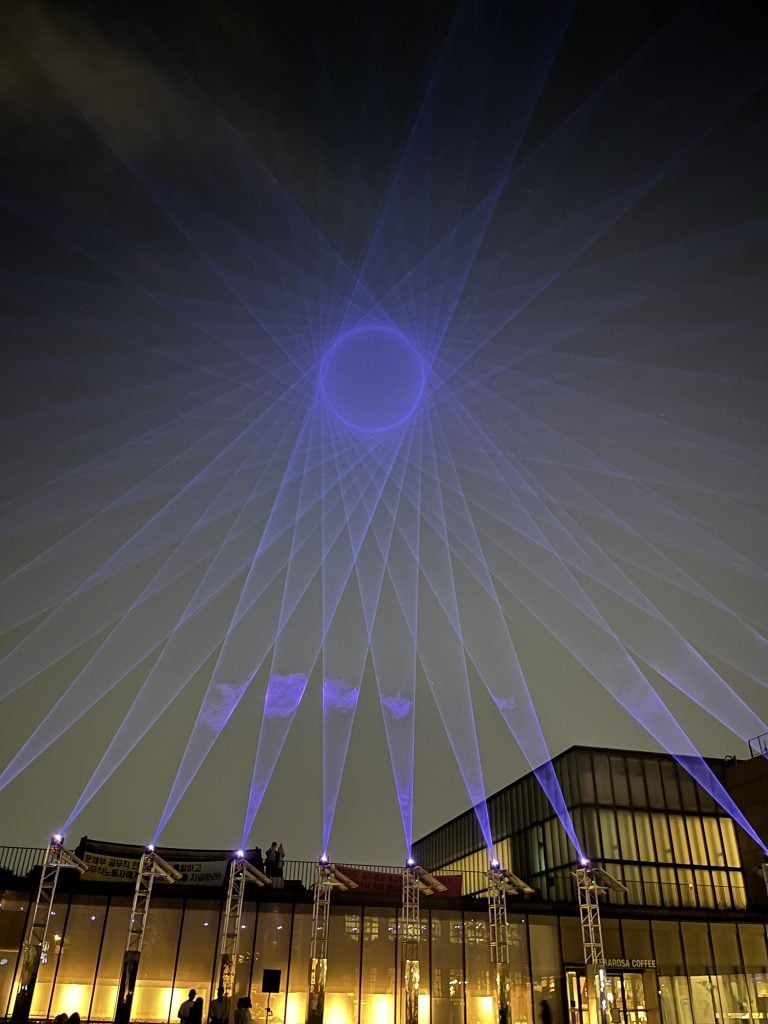
Sleeper hits, feminist blockbusters, and a 'night of 100 chickens': South Korea's capital was alight during Frieze

Andrew Russeth

The single best thing that I saw during Frieze Seoul?
A friend asked me right when I got back to New York earlier this month, and I had to stop and think. There were too many highs, too many surprising delights. There was a great deal of dross, too. (What art week doesn’t have that?) But the third edition of Frieze had the capital city, and South Korea as a whole, in peak condition. Galleries and museums staged ambitious shows and stayed open late. Smart, tough editions of revered biennials awaited further down the peninsula, in Busan and Gwangju. The festivities felt more cohesive than those of Frieze’s first two outings. The mood was giddy, buoyant, precarious.
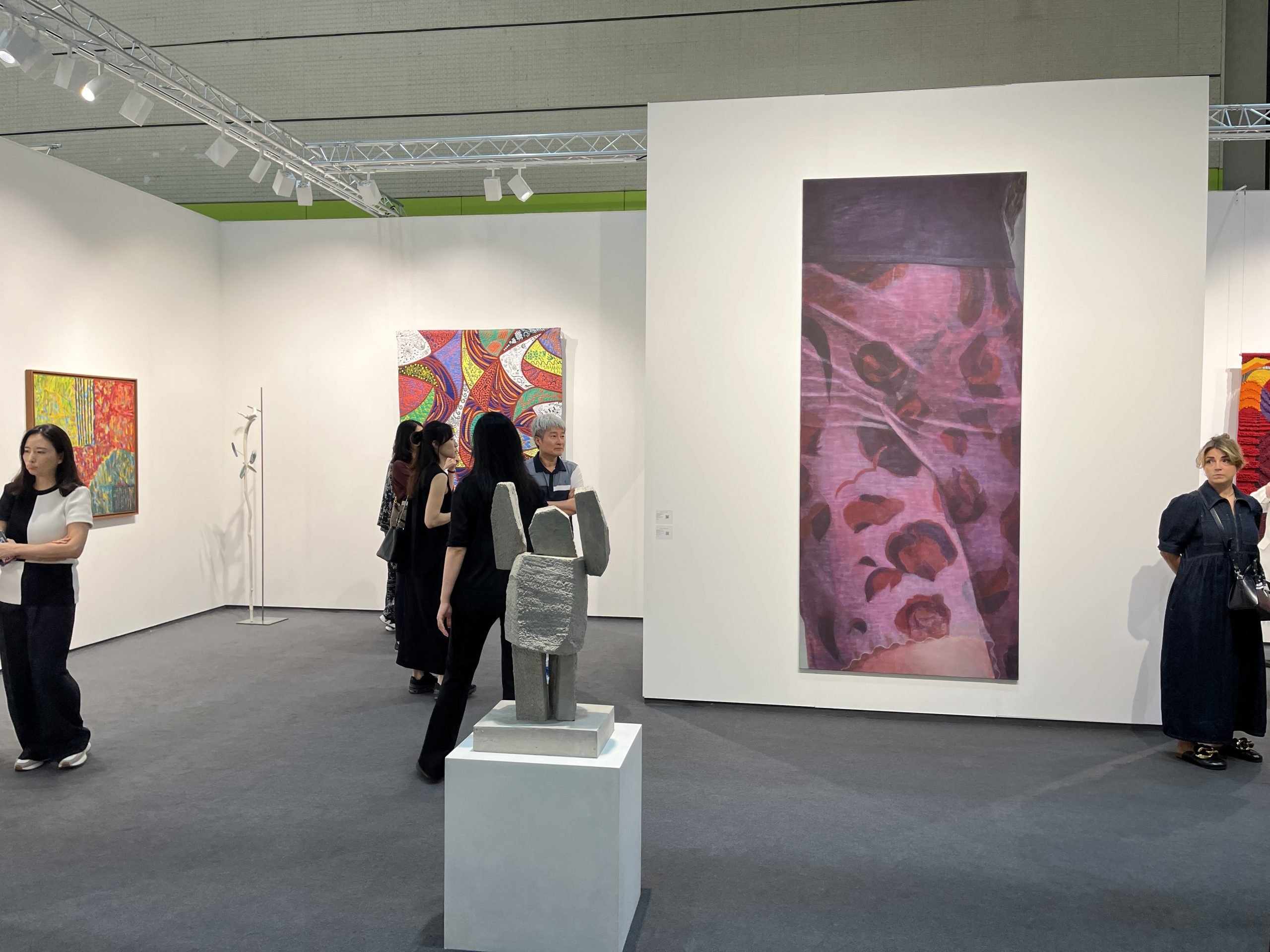
Best in show at Frieze was in the booth of New York’s Tina Kim Gallery: This 9-feet-tall painting of beskirted legs from 2001–04 by the superb Kang Seok Ho, who died in 2021, only 50. Alluring, surreal, intimate, and strange.
Sure, huge deals were not getting done at Frieze and the homegrown Kiaf at the Coex convention center, but art was selling, and people were having a ball. Art was everywhere, corporate tie-ins were everywhere, and the parties just kept coming.
On the opening night of the fairs, you could venture north of the Han River to the Samcheong neighborhood, which is home to some veteran blue-chip firms, and find hundreds of people perched on plastic stools in Kukje Gallery’s capacious courtyard. The revelers were eating fried chicken and swilling beer from a row of taps (an act of generosity hard to imagine in New York), then visiting punchy solo shows by Kyungah Ham and Michael Joo that are open through November 3.
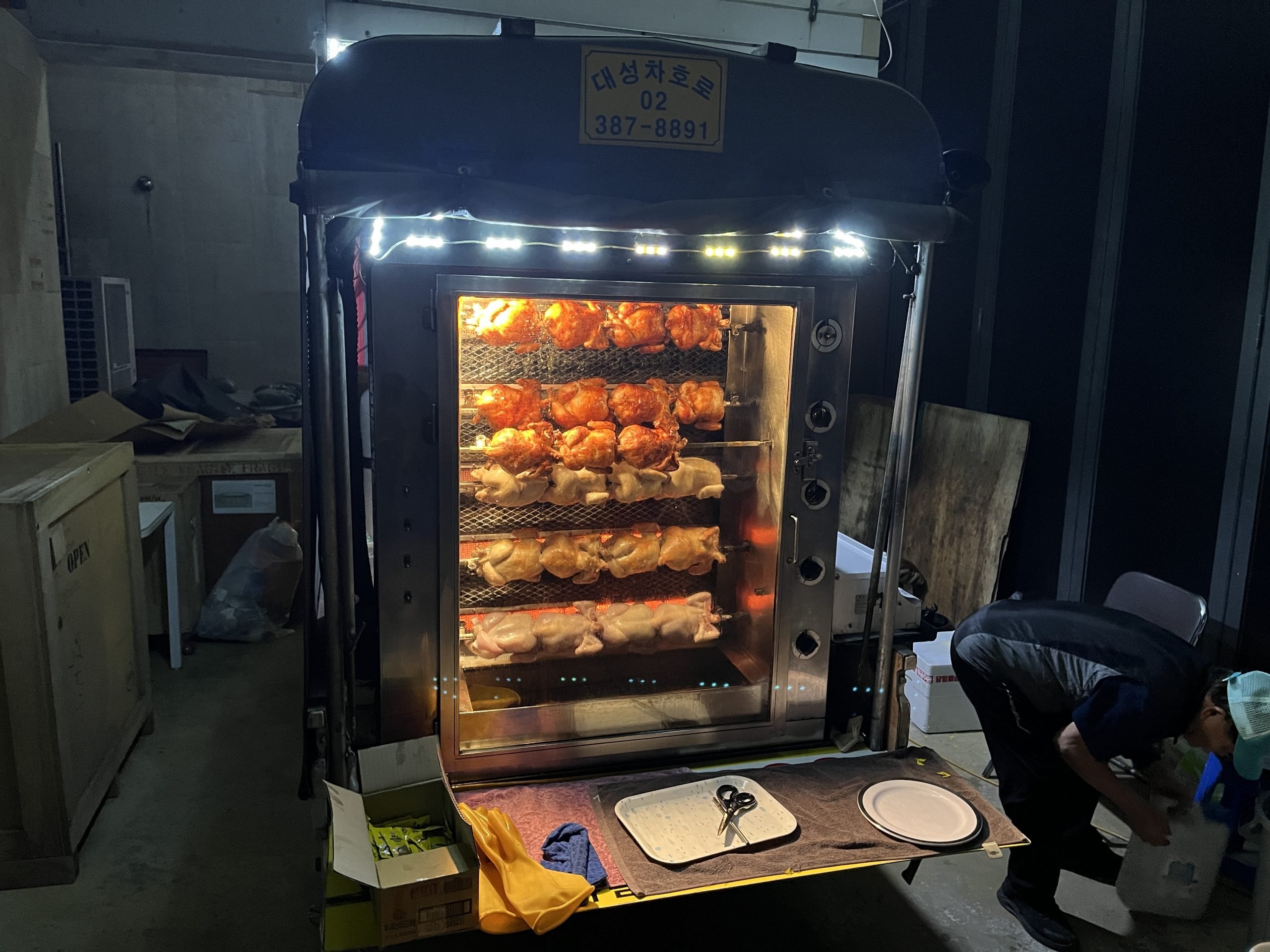
At Gallery Shilla, the chickens just kept coming.
Gallery Shilla termed its event “The Night of 100 Chickens,” and offered to all comers heavenly roasted birds from the back of a truck. It was toasting a show by the Mono-ha sculptor Kishio Suga titled “20 Years” (which is how long he’s worked with Shilla). The centerpiece of the affair, which runs through October 19, is Multiple Existence (2014), a circle of short cement columns topped with black rocks—a kind of room-sized Stonehenge, enigmatic and powerful, with a small opening for you to enter.
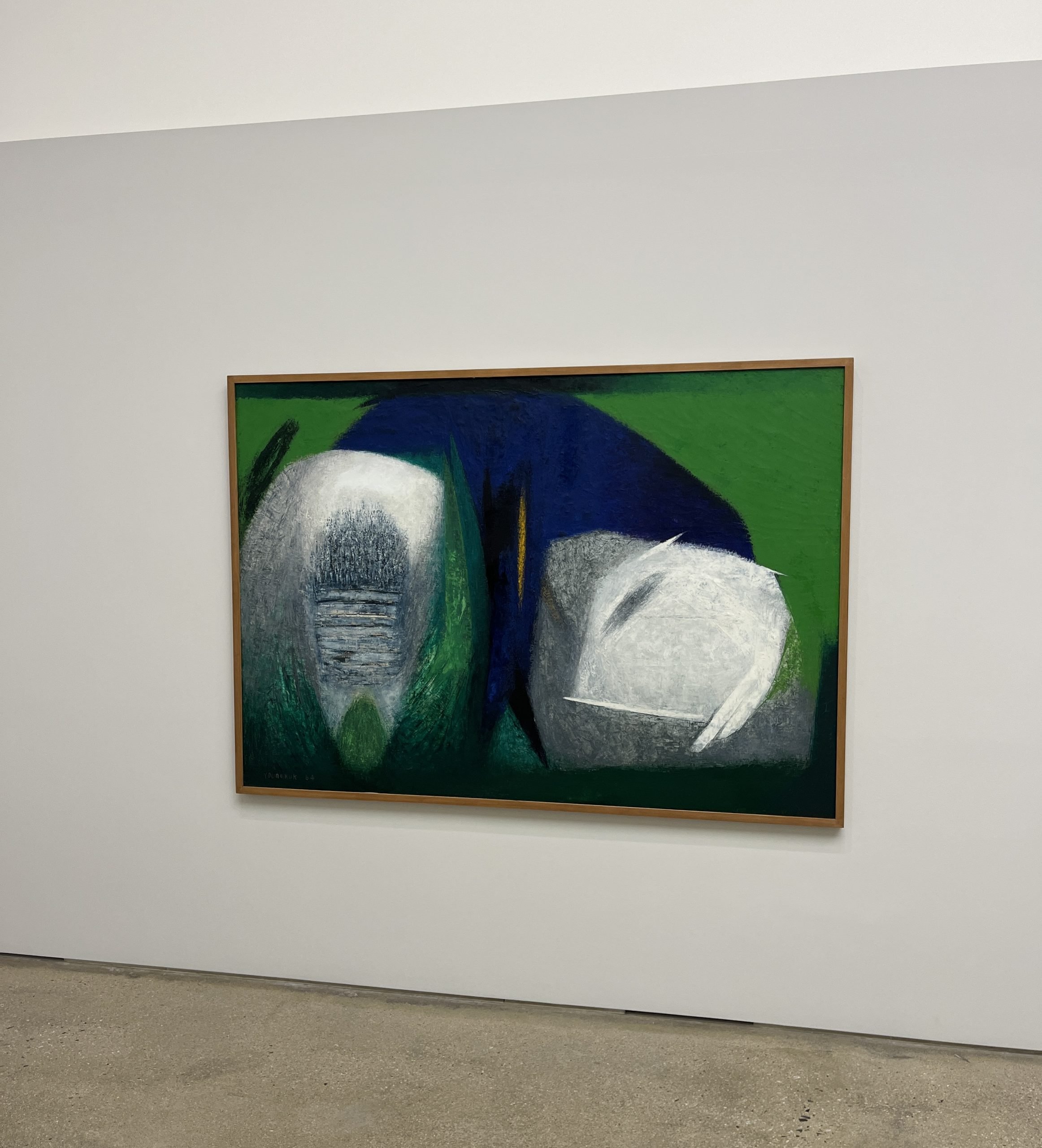
Yoo Youngkuk, Work (Terra Firma), 1964, at PKM Gallery. Buy some for your local museum.
Meanwhile, PKM Gallery had DJs and drinks for its radiant exhibition of the Korean modernist Yoo Youngkuk (1916–2002), “Stand on the Golden Mean” (through October 10). Yoo made hard-edge abstractions that pull their power from the natural world. They are bracingly succinct. Until last year, when Pace did a New York show, he had never had a solo show beyond Korea. Now there’s a collateral event at the Venice Biennale. Everyone should know him.
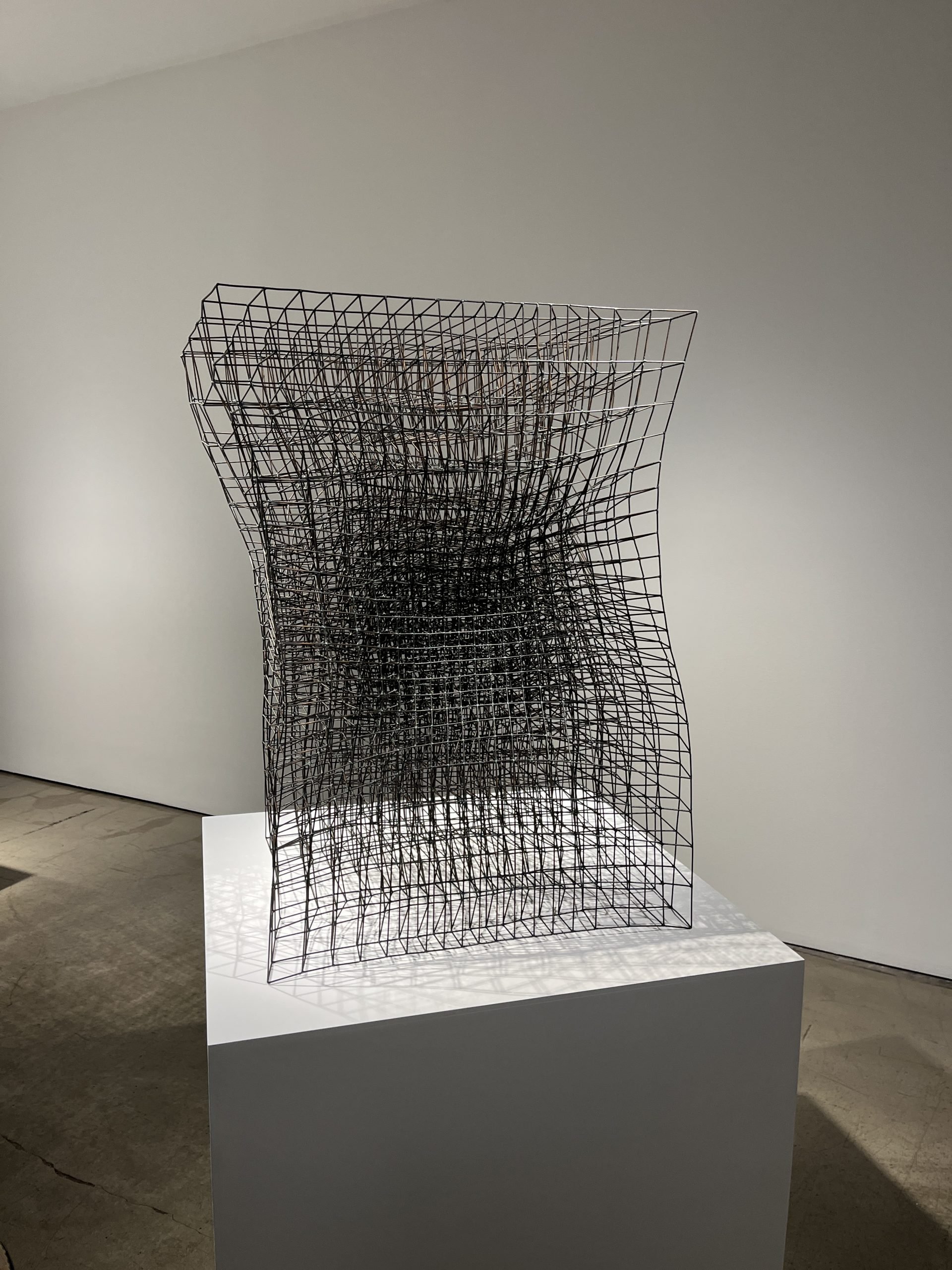
An untitled work by John Pai from the 1980s at Gallery Hyundai.
Like Kukje, Gallery Hyundai was hosting a doubleheader—the intricate abstract sculptures of the Korean American octogenarian John Pai in one of its buildings (through October 19) and a show in partnership with the esteemed Los Angeles outfit Commonwealth and Council in the other. The collabo, “Open Hands,” ran only two weeks (through September 15), which is a shame because it had some gems, like a pair of boots bearing carved Crocs, both carved from wood, a piquant display of taste and ornamentation by Eusung Lee.
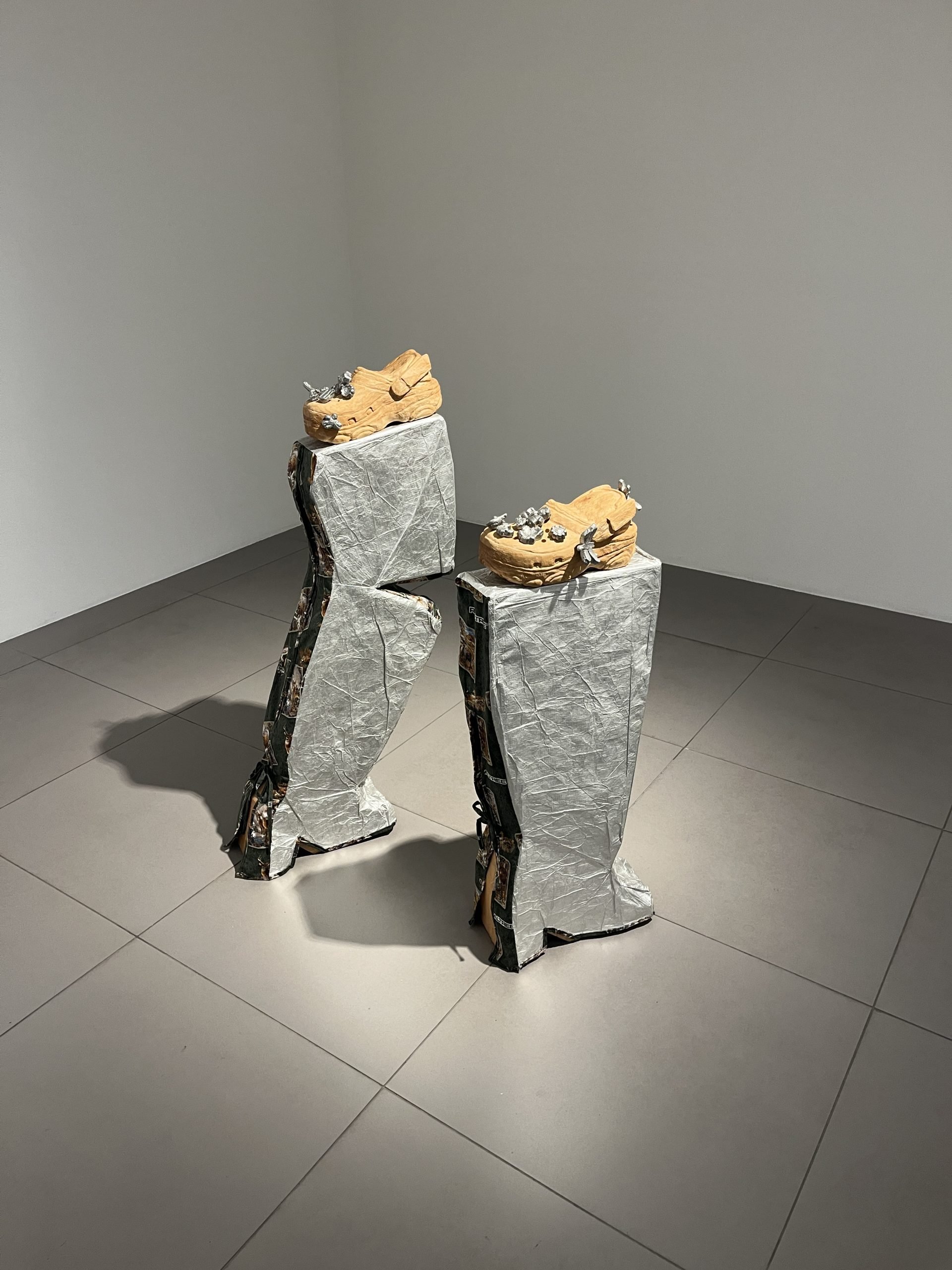
Eusung Lee’s Dandelion Acceleration (2020) in “Open Hands,” a collaborative show between Gallery Hyundai and Commonwealth and Council.
One hub of activity that night was the main location of the National Museum of Modern and Contemporary Art (MMCA), where the (toothsomely named) duo Kimchi and Chips used 33 laser projectors to create an artificial purple moon outside. (See the image up top.)
Inside, the MMCA was inaugurating “Connecting Bodies: Asian Women Artists,” easily the most divisive show in town, with some 130 works by more than 50 modern and contemporary figures from around a dozen countries. Complaints I heard: the installation is too jam-packed (certainly true), the selection of names is a bit random, and the premise is retrograde.
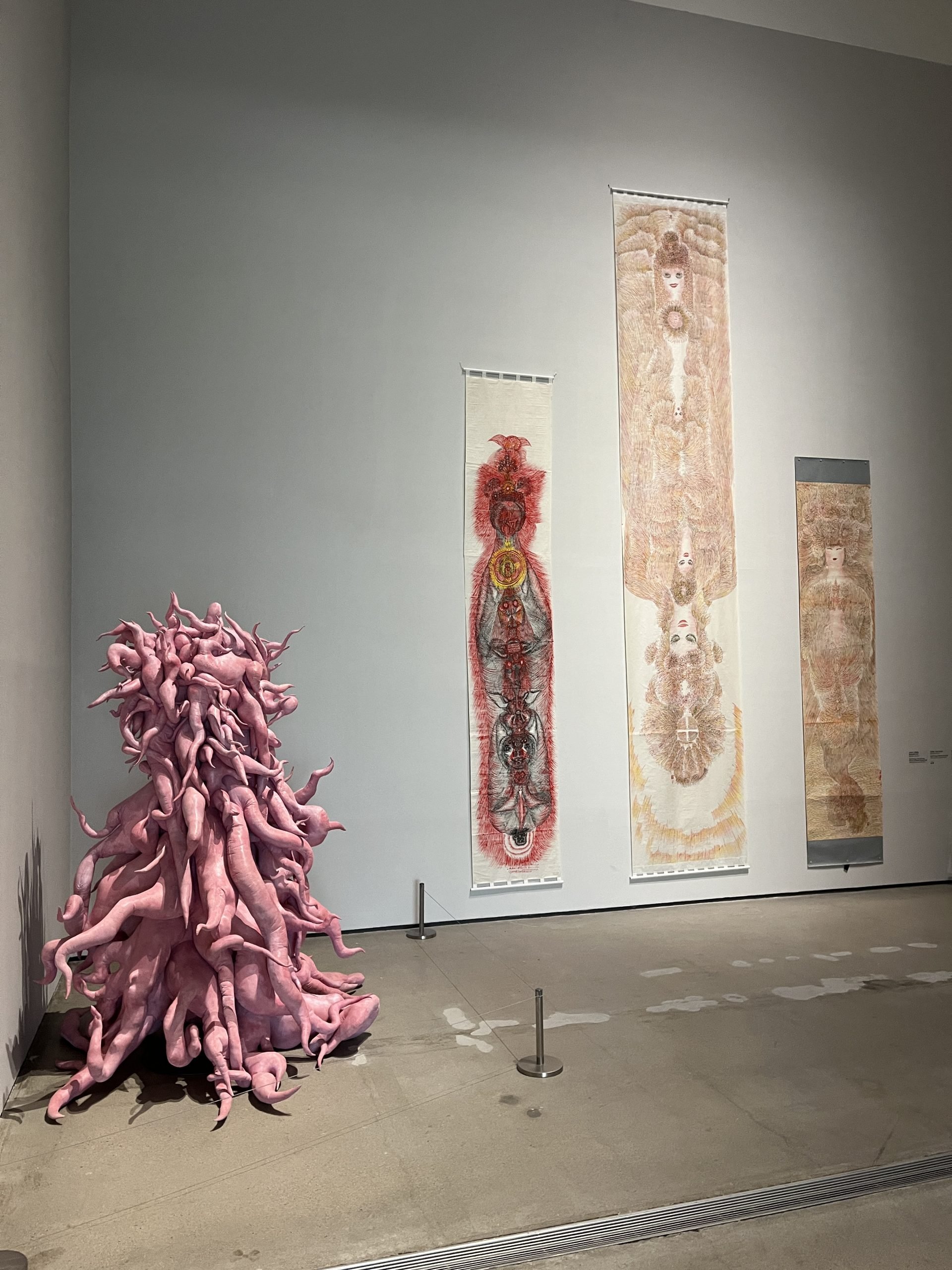
Lee Bul’s Monster: Pink (1998/2011) next to a trinity of drawings by Guo Fengyi in “Connecting Bodies” at the MMCA’s main Seoul branch.
That’s all fair enough, but it is impossible for me to begrudge a show with major pieces by, among many others, Guo Fengyi (her frenetic drawings of spectral beings are paired with a monstrous sculpture by Lee Bul), Theresa Hak Kyung Cha, Pacita Abad, and Atsuko Tanaka, particularly when many of those pieces have rarely or never been seen in Korea.
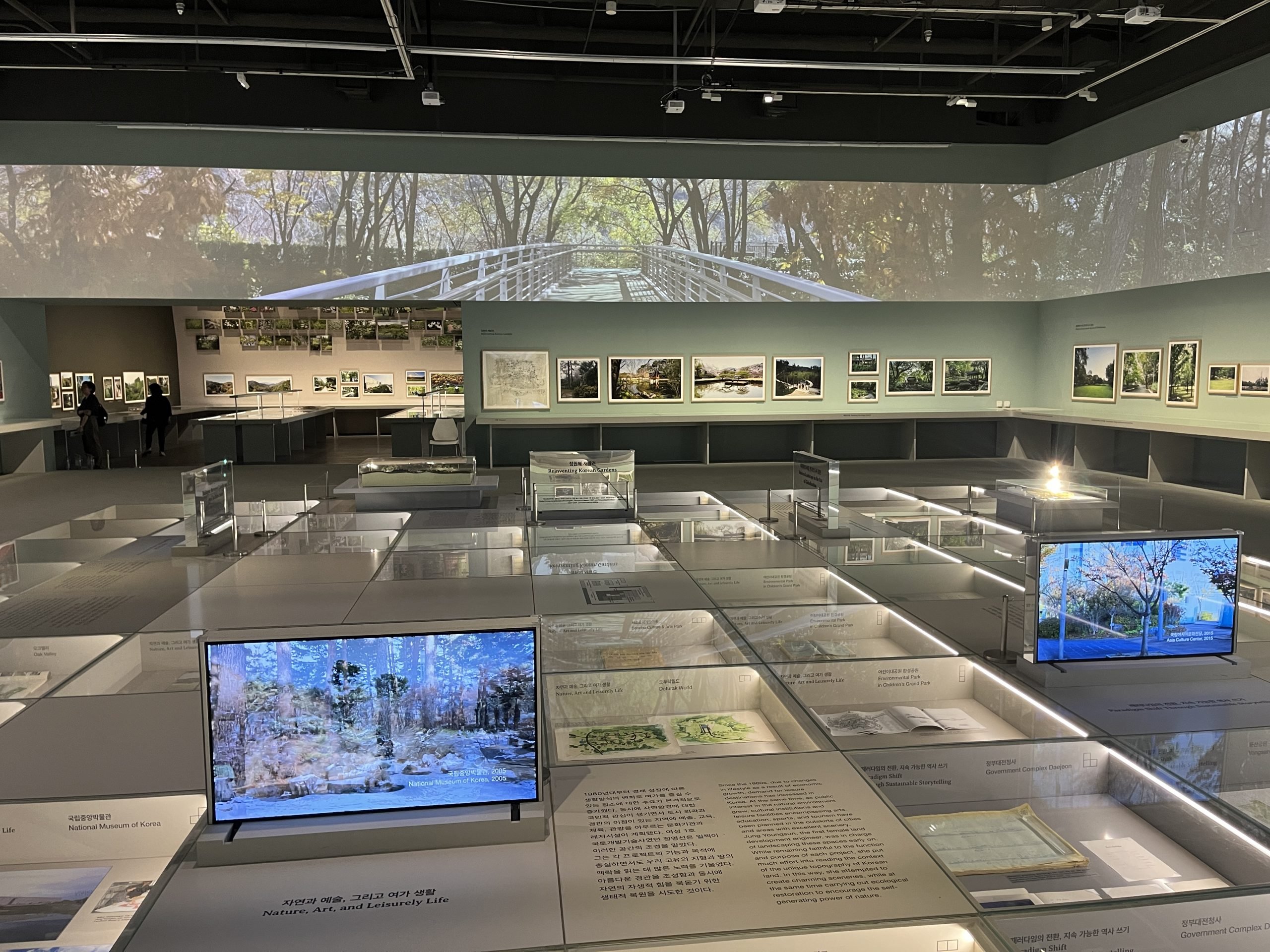
One of the breakout hits of the week: “Jung Youngsun: For All That Breathes on Earth” at the MMCA
The MMCA also delivered one of the sleeper hits of the week, a survey of the landscape architect Jung Youngsun, “For All That Breathes on Earth,” which just closed. Yung, who is 63, was the first woman licensed as a land-development engineer in South Korea, and she has helmed an astonishing number of landmark public projects in the country. They include the Gyeongchun Line Forest Trail in Seoul, an almost 4-mile-long park built along a decommissioned rail line (it’s like a street-level High Line that cuts through the city: tranquil, popular, and judiciously paced), and the traditional garden at Samsung’s Hoam Museum of Art in Yongin (where Nicolas Party now has a show).
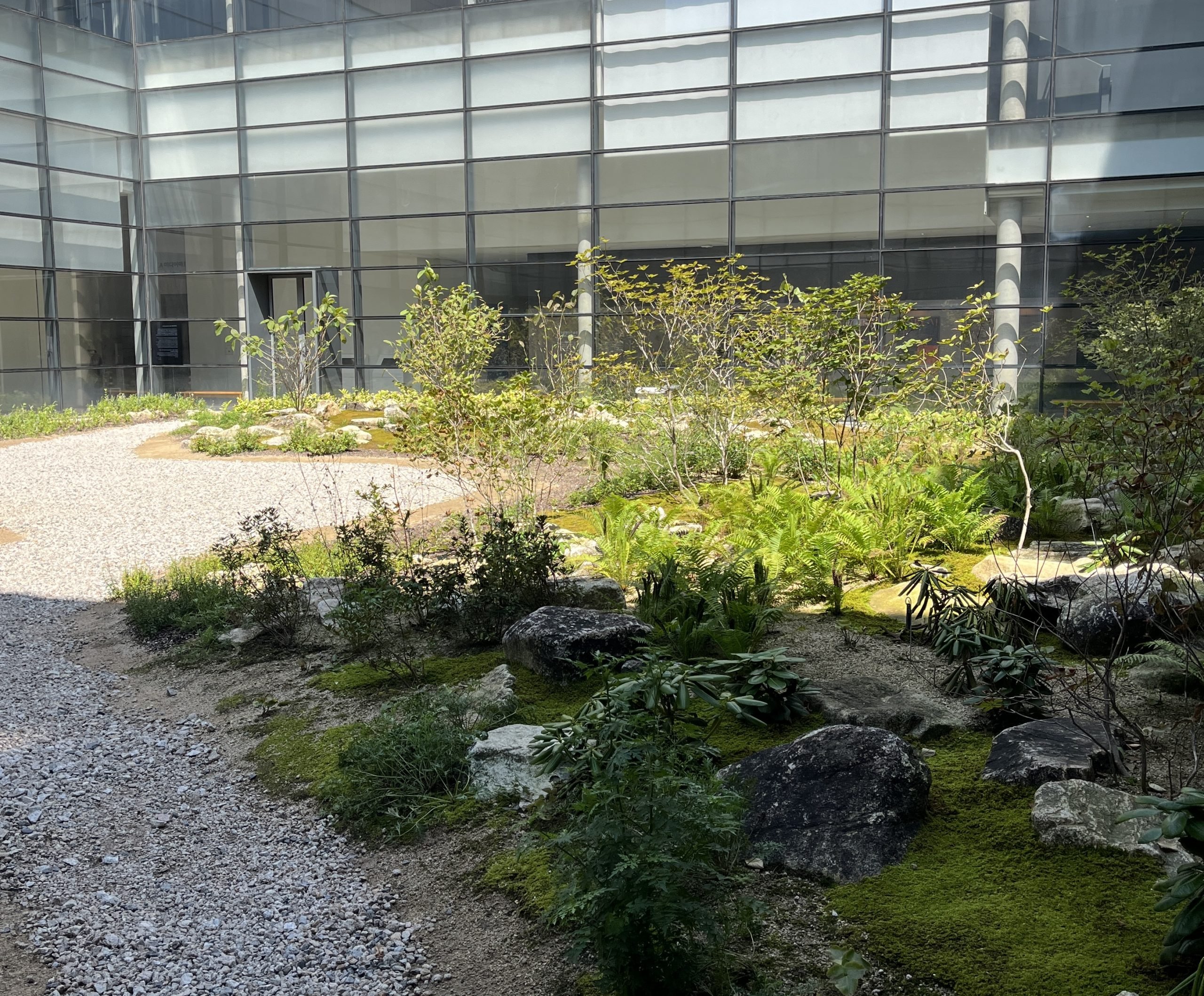
A little garden respite designed by Jung Youngsun as part of her show at the MMCA.
Presenting massive outdoor works in a museum is obviously not simple, but curator Lee Jihoi managed it, in high style, by arraying photos, models, drawings, and videos throughout the galleries, including some underfoot. A sense of plentitude—of sharp, restrained ideas, well-executed—prevailed. In a museum courtyard, Jung created a rustic environment to offer a taste of her light touch and respect for the natural world. “I hope that the gardens we tender, stroke, and nurture will be a source of inspiration and a moment of healing and recovery for all,” she once said. Those are words to live by.
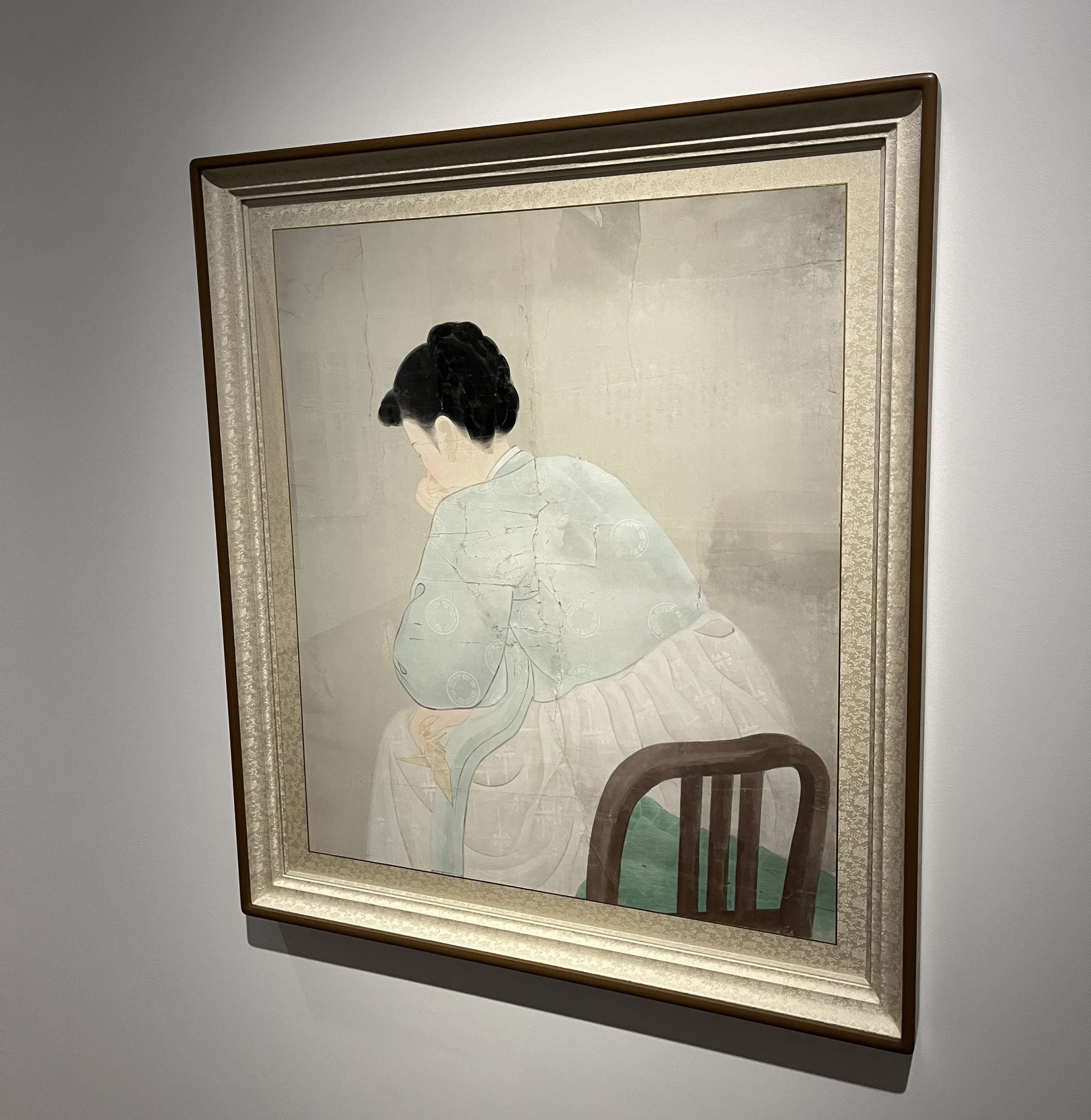
Park Rehyun’s Woman (1942) in “Turbulent Times” at the Seoul Museum of Art.
The MMCA was just one of three major institutions taking an all-women approach for a sprawling group show. The ARKO Art Center hosted 16 women sculptors, including Venice Biennale star Kim Yun Shin, in “ZIP,” which closed on September 8, and the Seoul Museum of Art (SeMA) has 23 women artists in “Turbulent Times: Women, Life” at its main location (one of eight!) through November 17.
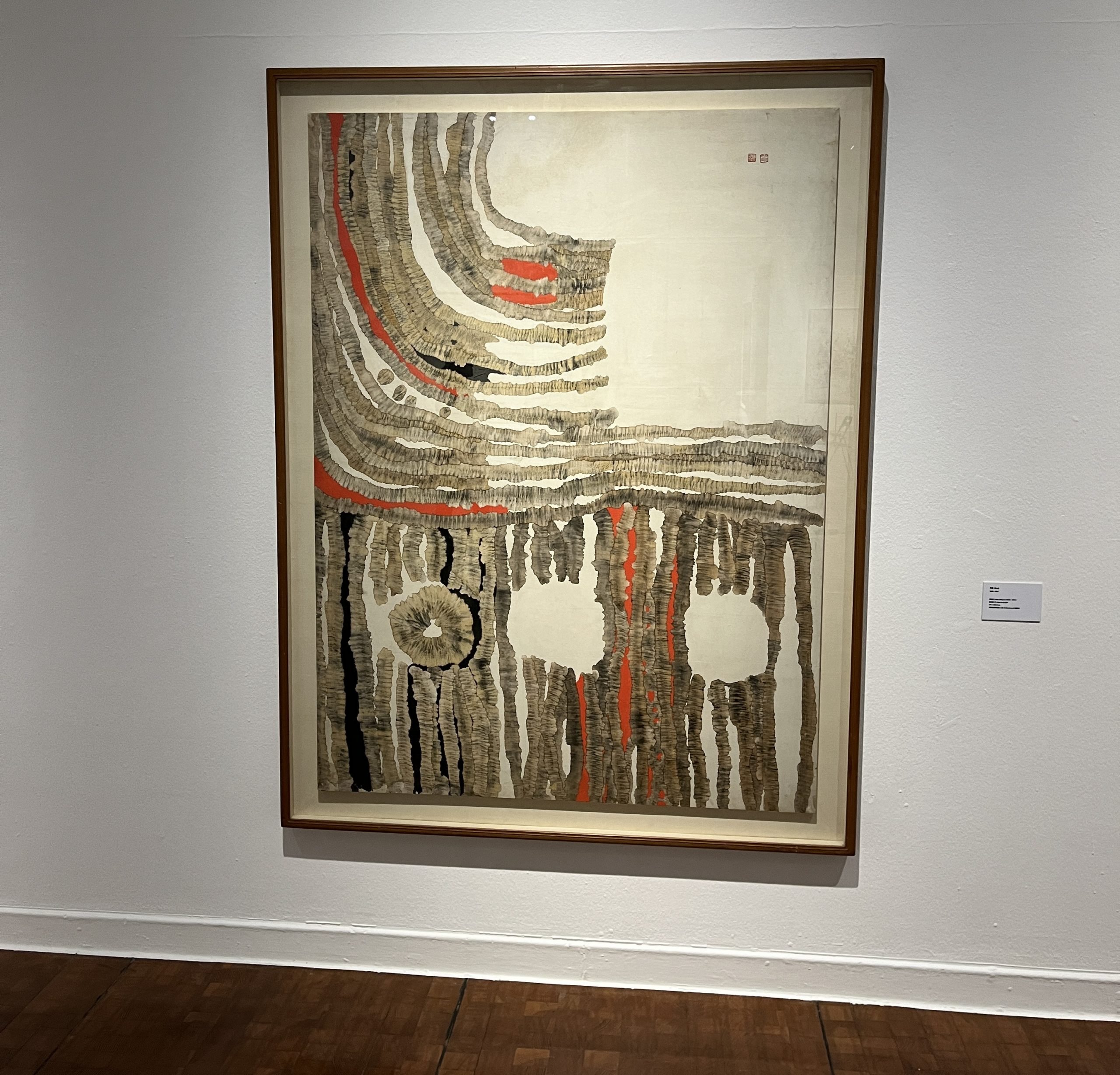
Another work by Park Rehyun in “Turbulent Times” at the Seoul Museum of Art, this one a venturesome abstraction titled Work (1966–67).
“Turbulent Times” was organized as part of SeMA’s centennial celebration of the birth of Chun Kyung-ja, a painter of charismatic and not-infrequently eccentric works who died in 2015 at 90. All of its participants were, to varying degrees, Chun’s contemporaries, though with quite varied artistic interests. They lived through many of the same unfathomably harrowing events—civil war, dictatorship, protests, and economic turmoil—while striving to develop careers in a deeply patriarchal society. Like the MMCA’s effort, this was a case of a show trying to cover too much ground in too little space, but it would be churlish to complain about seeing treasures from canonical figures like Lee Whaja and Park Rehyun.
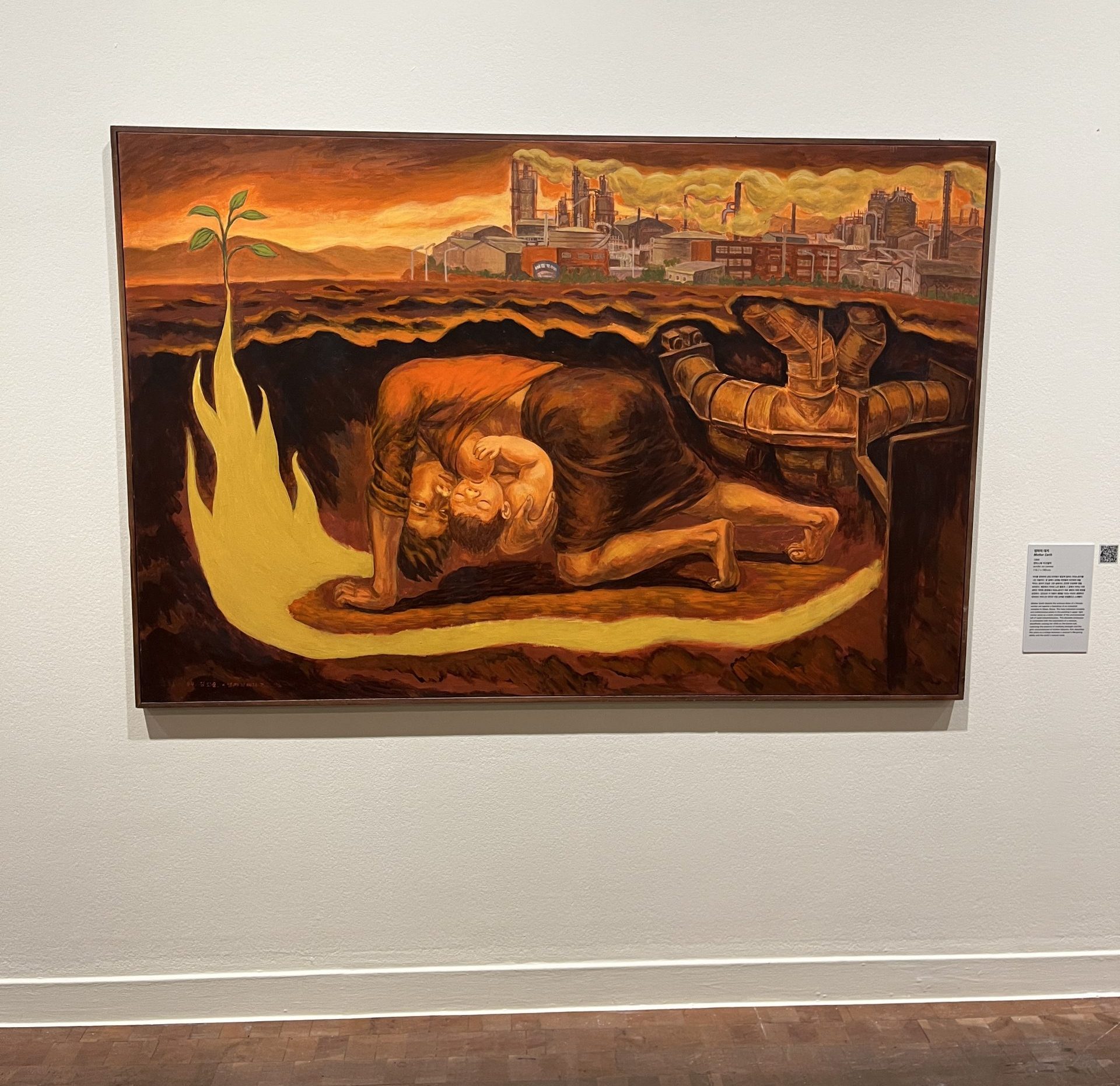
Kim In Soon’s Mother Nature (1994) at the Seoul Museum of Art.
A bonus offering at SeMA right now: an exhilarating display of unflinching paintings by the feminist painter Kim In Soon, 83 this year. One choice example of her work, the earth-colored Mother Nature (1994), has a woman on her hands and knees, nursing a small child, in the soil underneath a factory. The show was assembled from a trove of work that Kim donated to the museum, and it’s up through February 23, 2025. (Those seeking more on female artists from Korea should order a copy of Korean Feminist Artists: Confront and Deconstruct, a richly illustrated tome by curator Kim Hong-hee that Phaidon is publishing next month.)
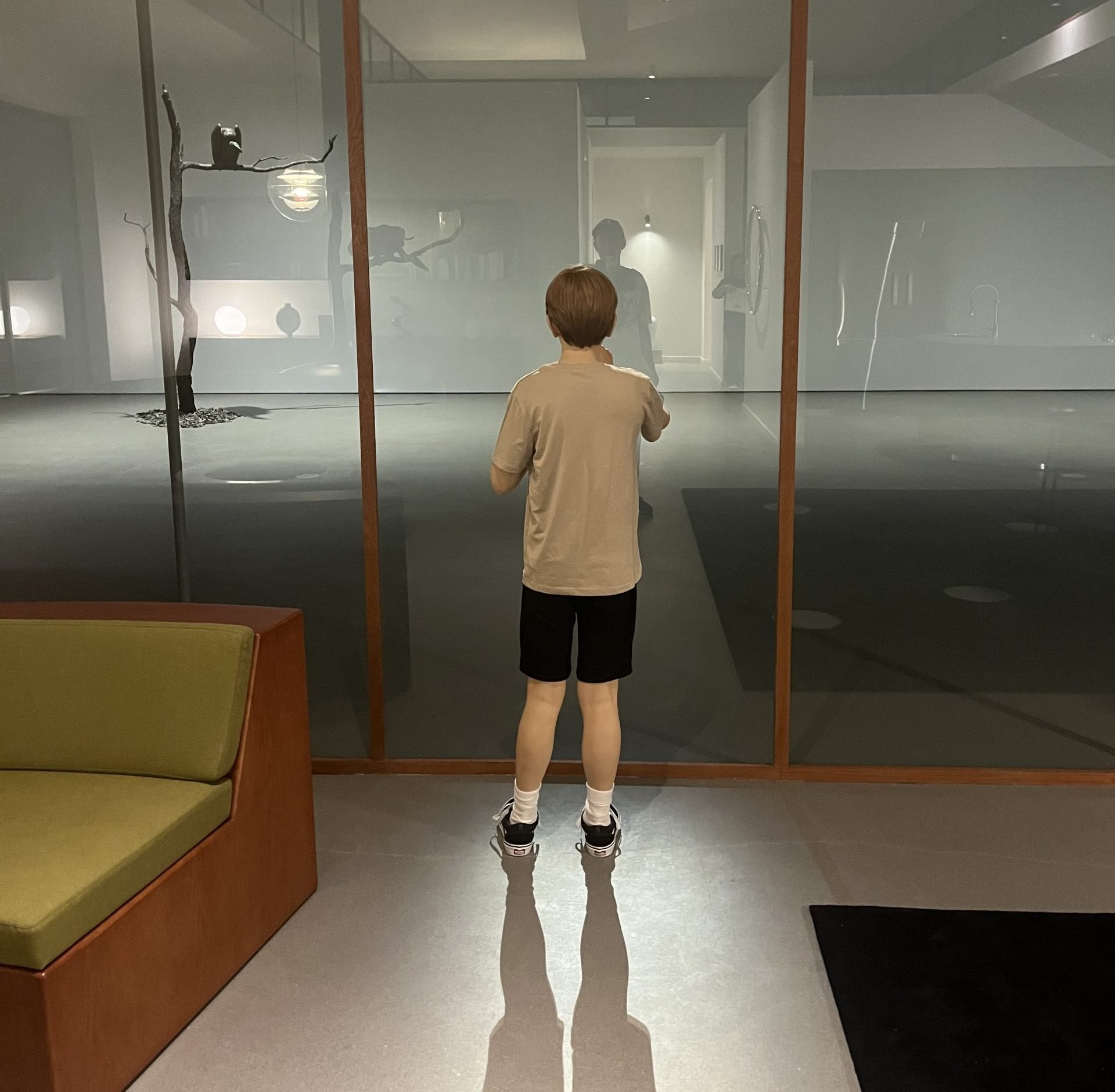
Installation view of Elmgreen and Dragset’s “Spaces” exhibition at the Amorepacific Museum of Art.
Other trends? How about . . . haunted houses!
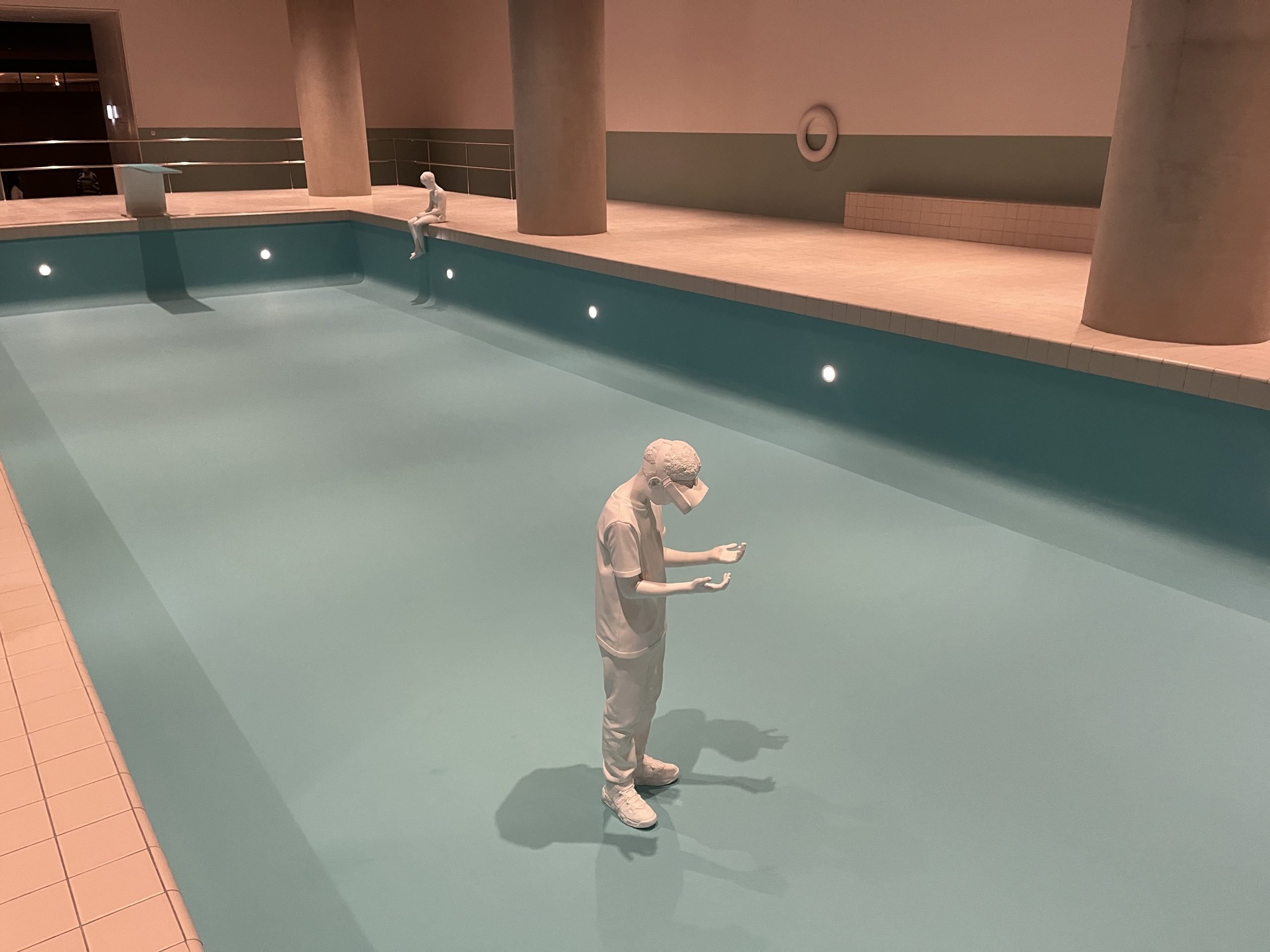
Lost in “Spaces” at the Amorepacific Museum of Art.
First, the bad. At its formidable David Chipperfield–designed museum in the Yongsan district, the beauty conglomerate Amorepacific has a massive Elmgreen & Dragset exhibition up through February 23, 2025, titled “Spaces.” It is enormous, and it is vacuous. Its banalities include a 1,500-square-foot modernist home, in which a life-size sculpture of a boy gazes eerily at a window. In its bathroom, a single pipe connects the drains of two identical sinks. One gallery over, another boy stands in a huge, empty swimming pool wearing VR glasses as he stares at his hands. With big-budget theatrics and pipsqueak imagination, the artists solemnly share this revelation: contemporary life is marked by alienation and ennui.
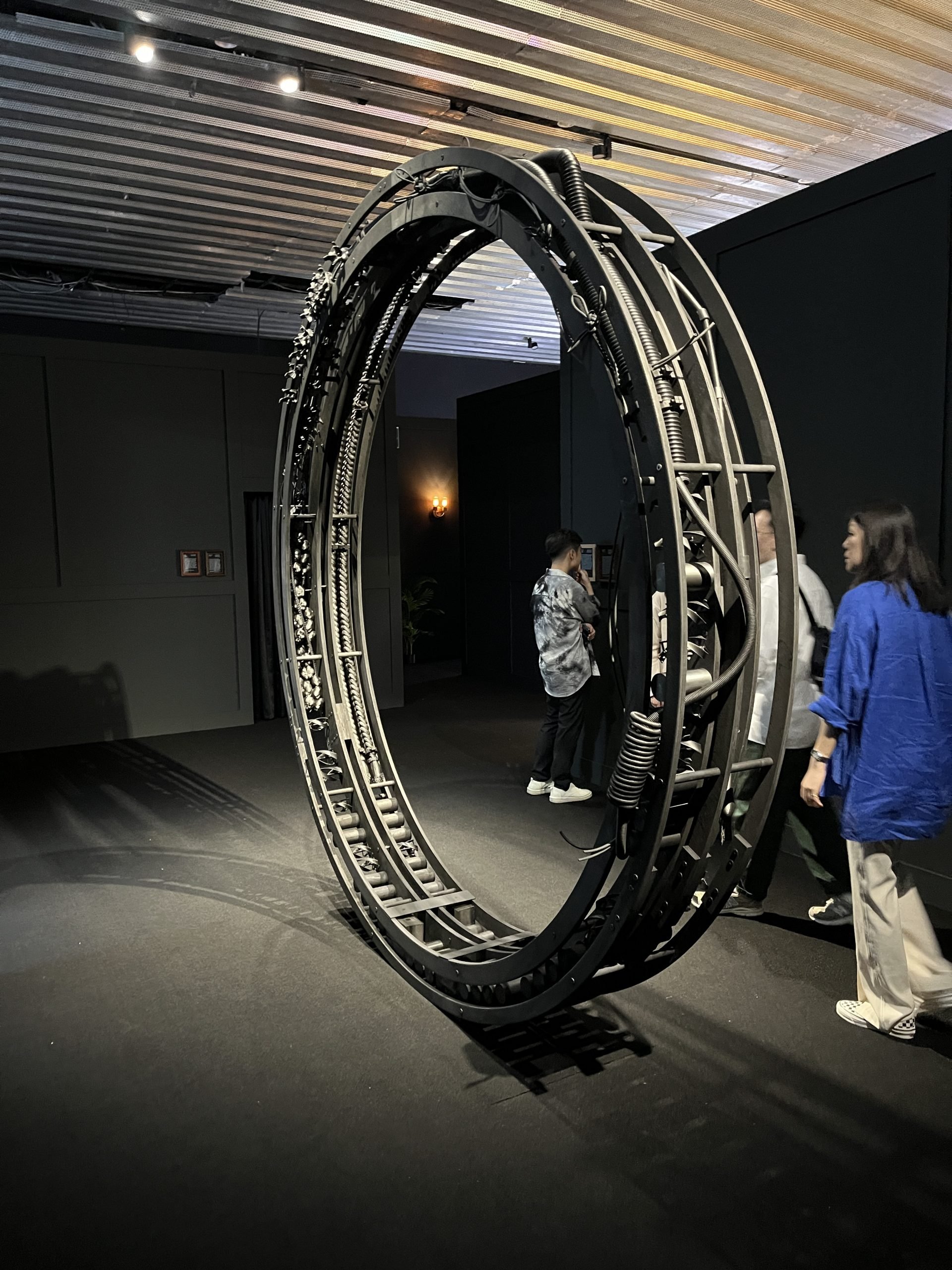
Priscilla Jeong’s Traveling Domestic (2024) in Rirkrit Tiravanija’s superb “Dream Screen.”
Now, the great. Over at the Leeum Museum of Art, Seoul’s most important art venue, the indefatigable Rirkrit Tiravanija tapped 26 Asian artists for an exhibition called “Dream Screen.” Running through December 29, it’s the latest edition of Leeum’s biannual “Art Spectrum” show for emerging artists. It’s a barnburner, with a design based loosely on the maze-like Winchester Mystery House in San Jose, Calif., which has some 2,000 doors. Entering the show, you encounter a beguiling, nearly 10-foot-tall ring sculpture by New Yorker Priscilla Jeong. Open a door and you’re in a bar from the international collective Sparkling Tap Water, where a band was jamming on opening night. Each black-walled room and hallway holds another intriguing piece, and out back is a 50-foot climbing wall-as-artwork by the Seoul-based Jihyun Jung. (My climbing attempt went poorly.) Strong work in a compelling space that presents it well: yes, please.
There were also haunted (or at least semi-haunted) houses in the Gwangju and Busan biennales, but let’s save those for proper reviews.
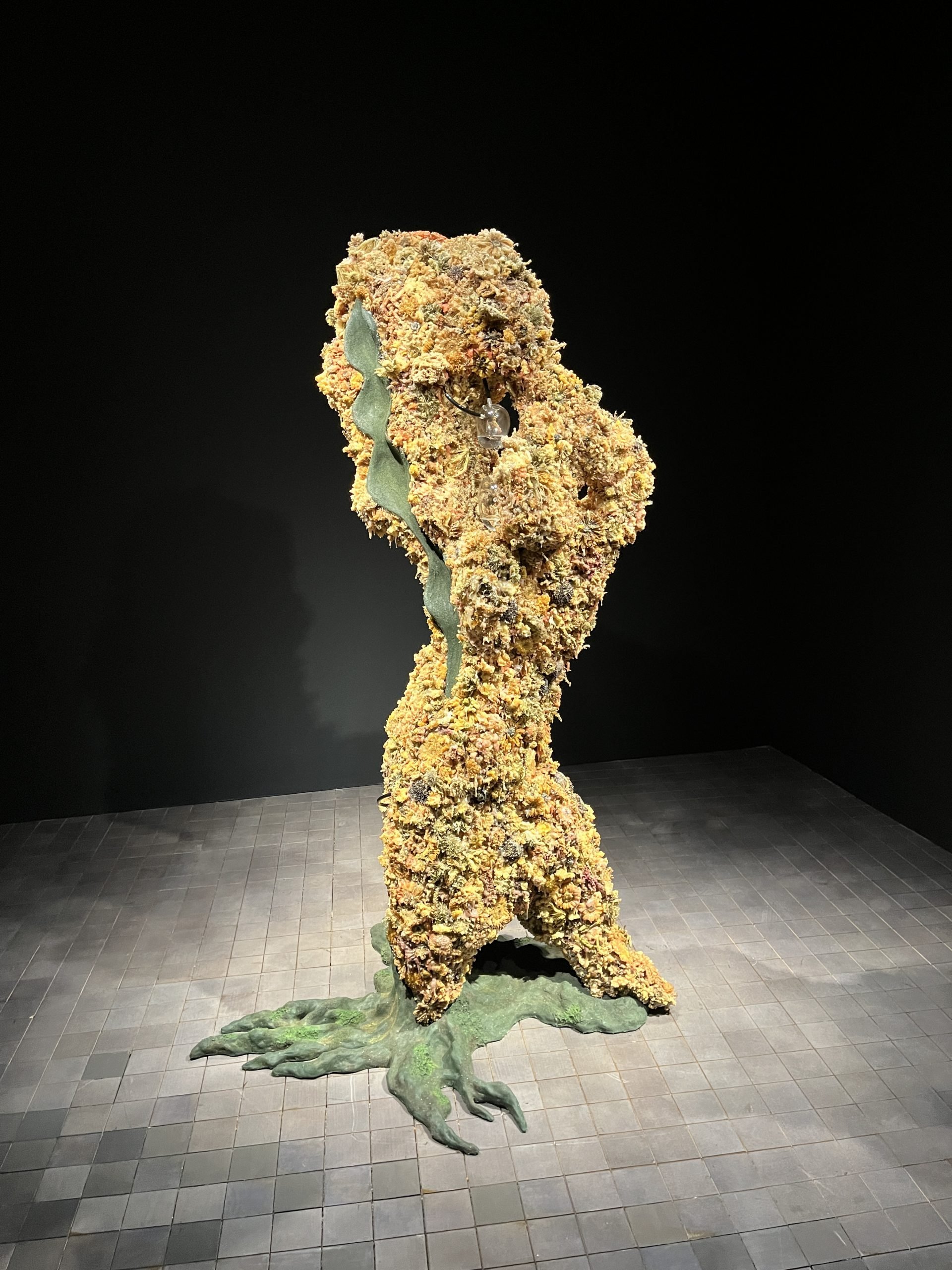
Anicka Yi’s Vinegar Fissure (2024) in her solo outing at the Leeum Museum of Art.
In another wing of the Leeum, Anicka Yi unveiled “There Exists Another Evolution, But In This One,” with 33 works, almost half of them made this year. Yi brought one of her early inventions, gloriously tempura-fried flowers, back into the mix, assembling them into standing abstract forms that suggest 3D sci-fi Arcimboldos: hallucinogenic contrapposto. The show is up through December 29, then heads to the UCCA Center for Contemporary Art in Beijing in an expanded form.
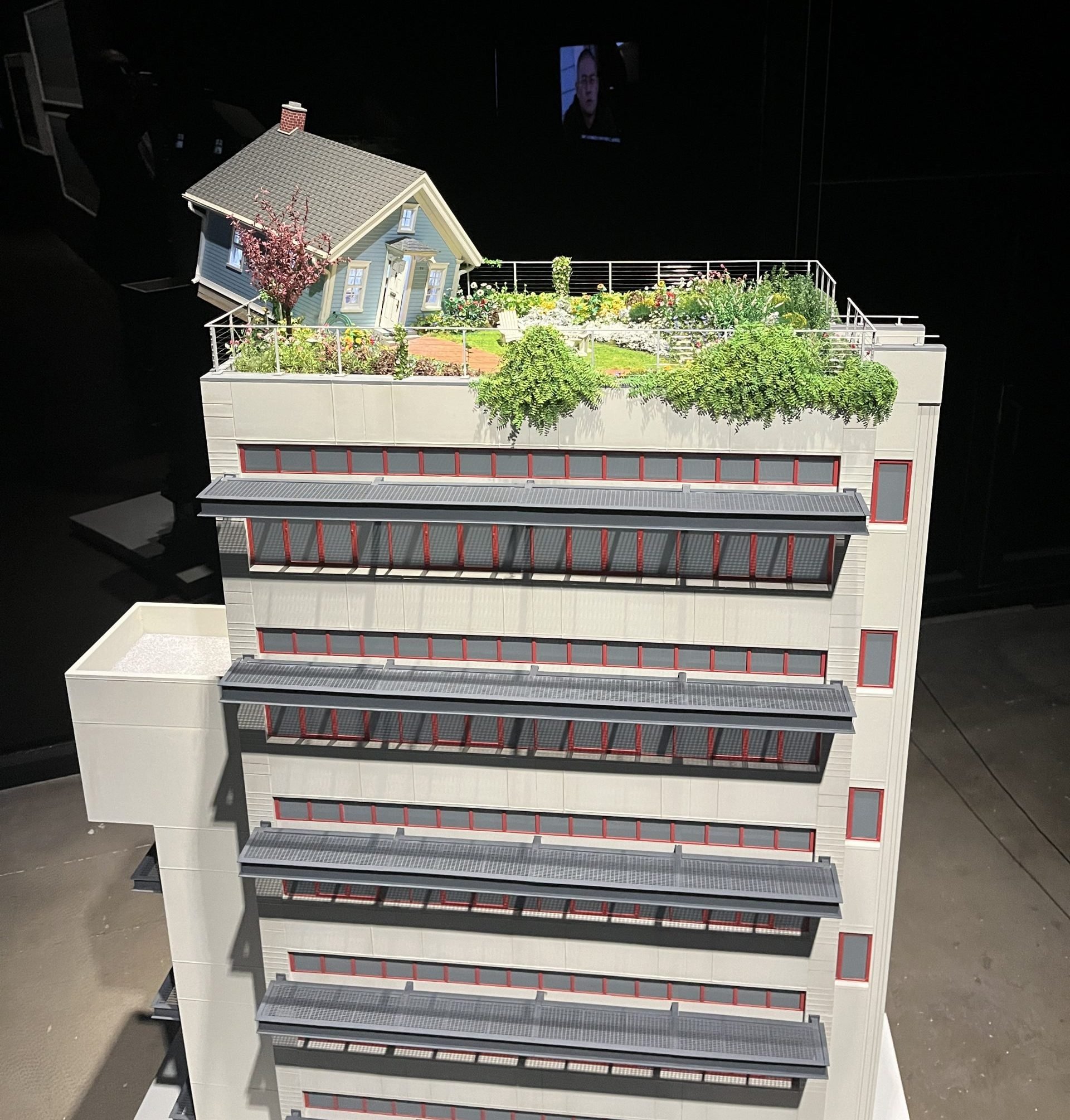
A Do Ho Suh sculpture related to his installation at the University of San Diego in California, Fallen Star (2012).
The houses that Do Ho Suh features in his art are not haunted, just deeply personal, filled with memories. At the Art Sonje Center, a proving ground for young talent that hosts the occasional star, Suh has a number of sculptures centered on the notion of an ideal home in a one-man show, “Speculations,” through November 3. A hanok (a traditional Korean house) and trees sit atop a flatbed truck in one of his miniature models. In another, a modest suburban abode has crash-landed on the green roof of an austere office building. It’s a moving exhibition, a portrait of an artist on the move, seeking firm ground, like us all, and it confirms that Suh is one of the signal talents of our times (and still underrated, despite his global renown).
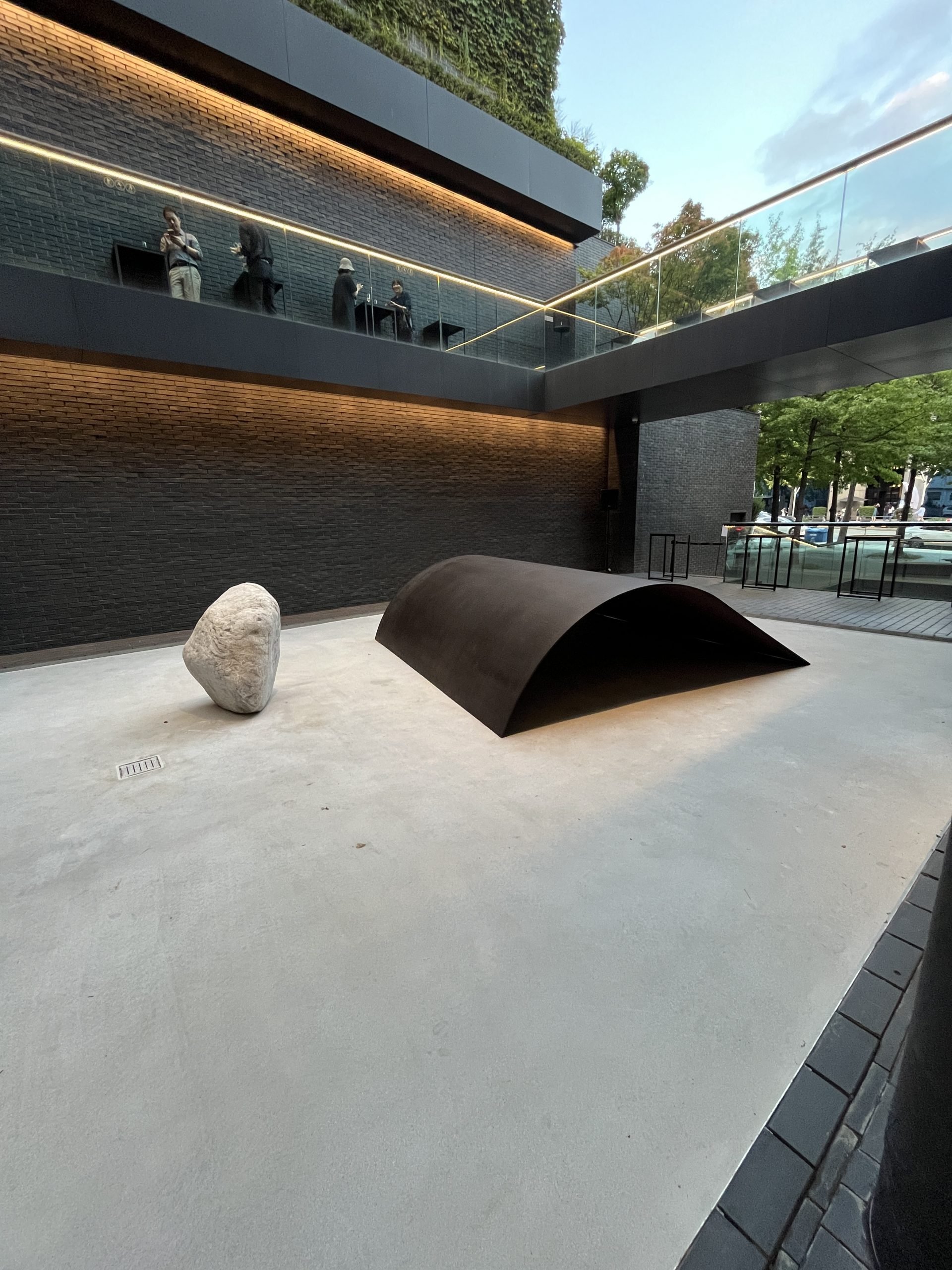
A Lee Ufan at Pace. Solid, stolid, unimpeachable.
Down the street from Leeum, Pace had the most impressive show of force of the week: “Correspondence,” a pairing of two giants of abstraction: Lee Ufan of Korea and Mark Rothko of the United States (and what is now Latvia). Each man got his own floor (wise not to intermix such singular aesthetic agendas), and the lines to enter have been enormous. A special bonus: Lee, who’s 88, installed a characteristically charming sculpture in the gallery’s courtyard, an upright white stone staring down a small hill of steel.
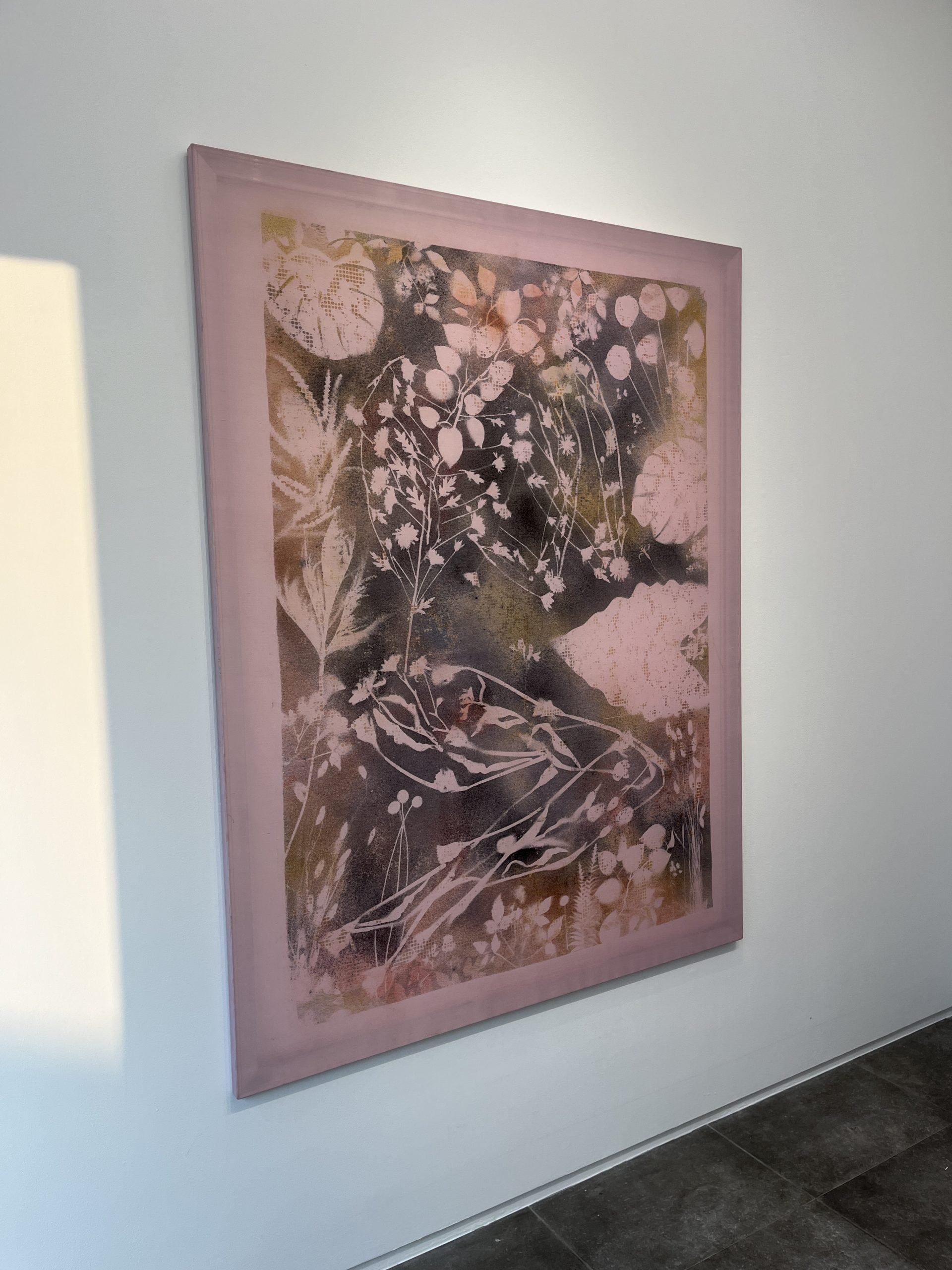
A Sam Falls botanical painting at Eva Presenhuber’s display in P21’s former space.
Pace opened in Seoul back in 2017, the same year Lehmann Maupin entered, and a flood of galleries from Europe, the U.S., and elsewhere in Asia has followed: Gladstone, König, Tang, Ropac, Peres, White Cube, and the list goes on. It’s an open question whether the market can accommodate so many competitors, but foreigners are continuing to try out the city. Zurich’s Mai 36 Galerie has a collaborative show with the local Paik Hae Young Gallery in the Itaewon area (through October 15), not far from where fellow Swiss firm Eva Presenhuber has mounted a bite-sized Sam Falls show, in a small space that was once part of the P21 gallery. Up through October 5, it has just three works, including one of those beautiful, melancholic pieces that Falls makes by setting plants atop canvas outdoors and letting their images transfer over time.
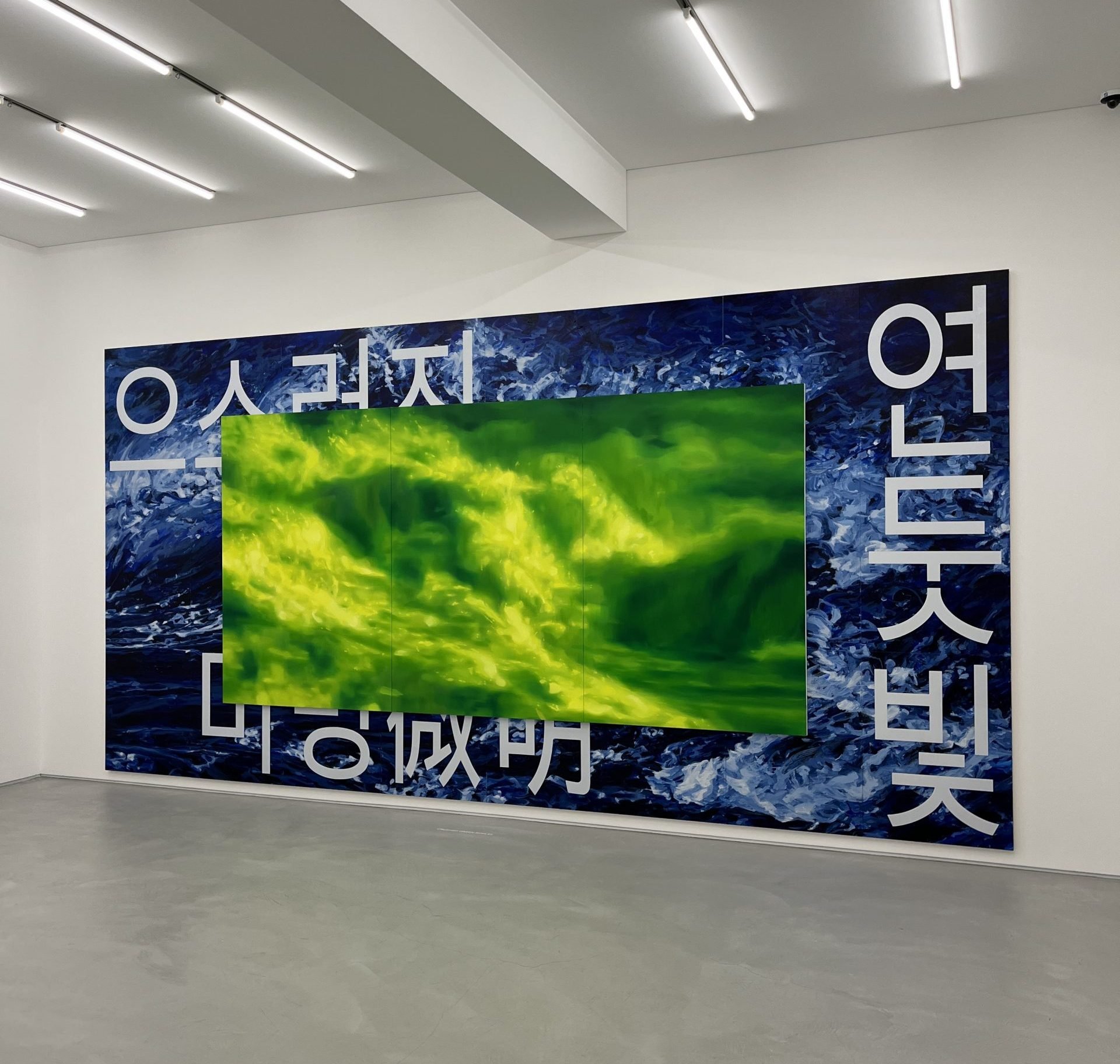
Keem Jiyoung’s 으스러진 연둣빛 미명 (2024) at P21.
P21, a stalwart supporter of venturesome Korean artists, moved into a bigger space earlier this year, where it has a solo show (through October 11) with Keem Jiyoung called “With Night’s Nape Between Our Jaws”: big, bright, meaty multi-panel paintings of waves overlaid with snippets of poetic text, written in hangul. They are potent. “We are briefly alive,” one reads. That is why, during an action-packed art week, there is no time to rest. You just have to keep going.
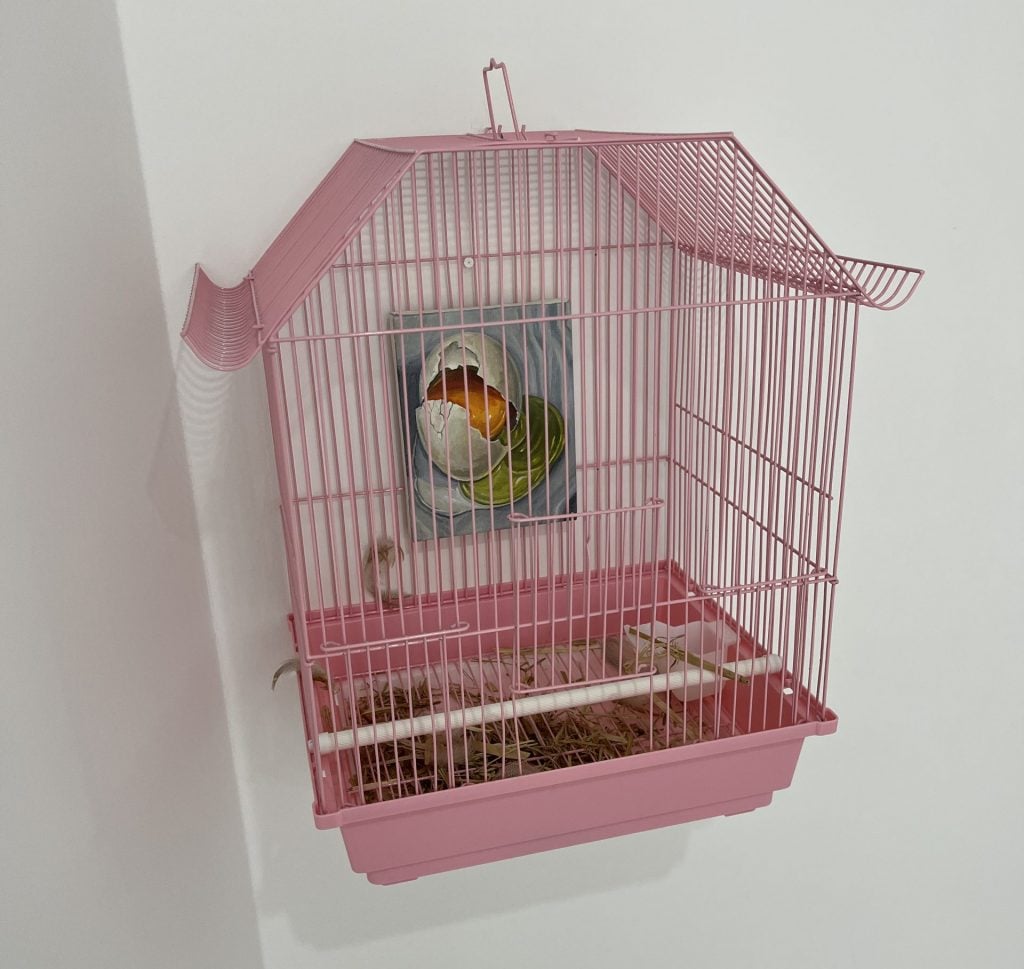
A work by the one-namer COBRA at Whistle.
Whistle, one more gallery championing emerging art (there are too few in Seoul), tapped three peers from around Asia for a group show: Kiang Malingue (of Hong Kong), Misako and Rosen (Tokyo) and ROH (Jakarta). That’s a lot of cooks in one kitchen! But the eight-artist presentation, “Transposition 1: Observing the Walking Patterns” (through October 19), was pleasantly coherent. The highlight: three odd, funny birdcages by COBRA (the founder of Tokyo’s XYZ Collective gallery), each containing a captive little painting.
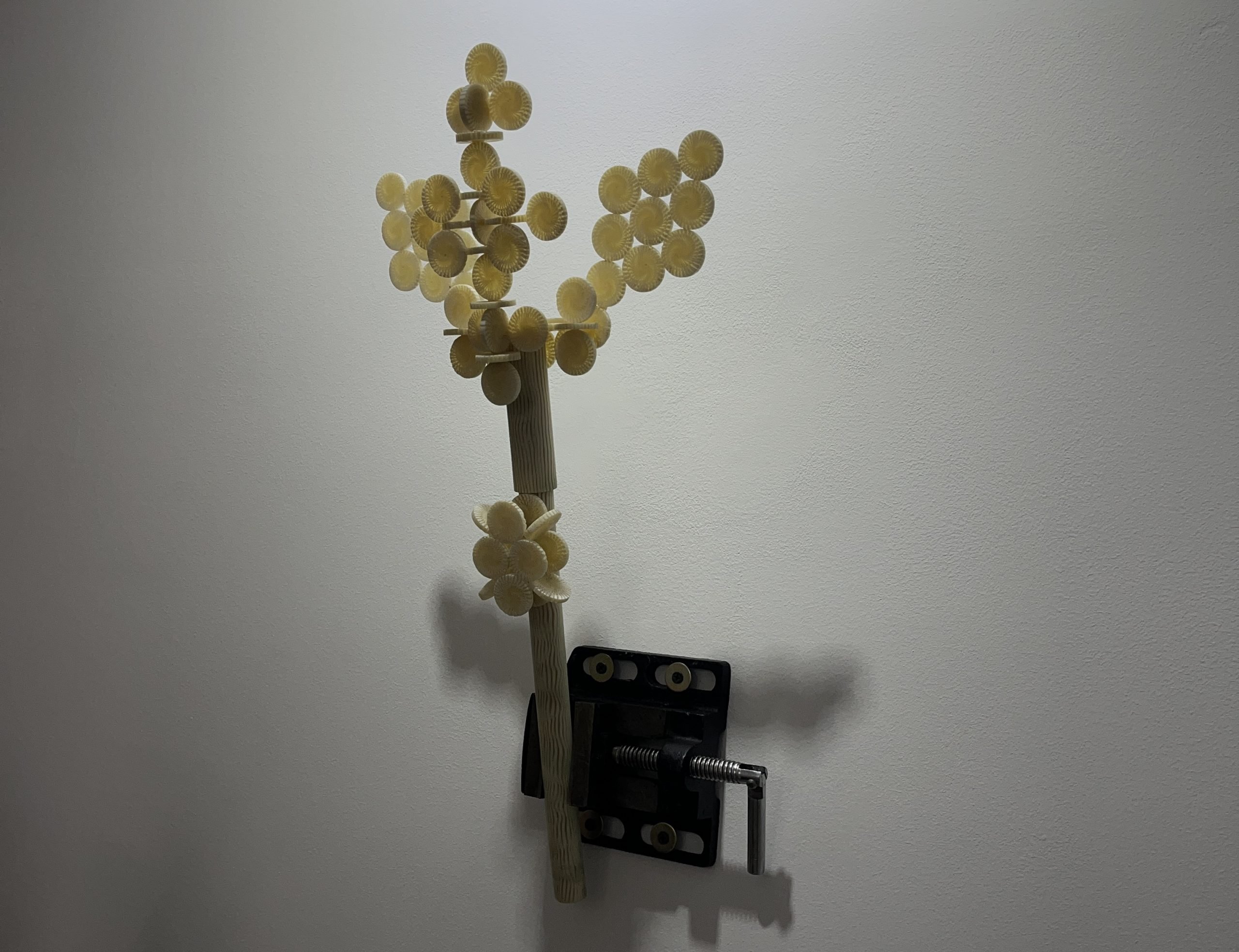
It is rare to see an object quite unlike any you have seen before. Behold, this Jan Tomza-Osiecki piece at WWNN.
Other highlights on the emerging end of the spectrum: the just-closed “Fairy Tales” at the newish WWNN (thank you to artists Sylbee Kim and Nico Pelzer for guiding me there!), which had some impressively surreal constructions by Jan Tomza-Osiecki and (quite an unexpected sight) enigmatic little ink-on-paper flower pieces by Luc Tuymans; young gun Sinae Yoo’s addictively alluring paintings in her solo show “Derivative Messiah” at the Doosan Art Center (through October 12); and Hwang Sueyon‘s wily paper constructions, some in a vaguely haunted shed, at G Gallery (closed September 28).
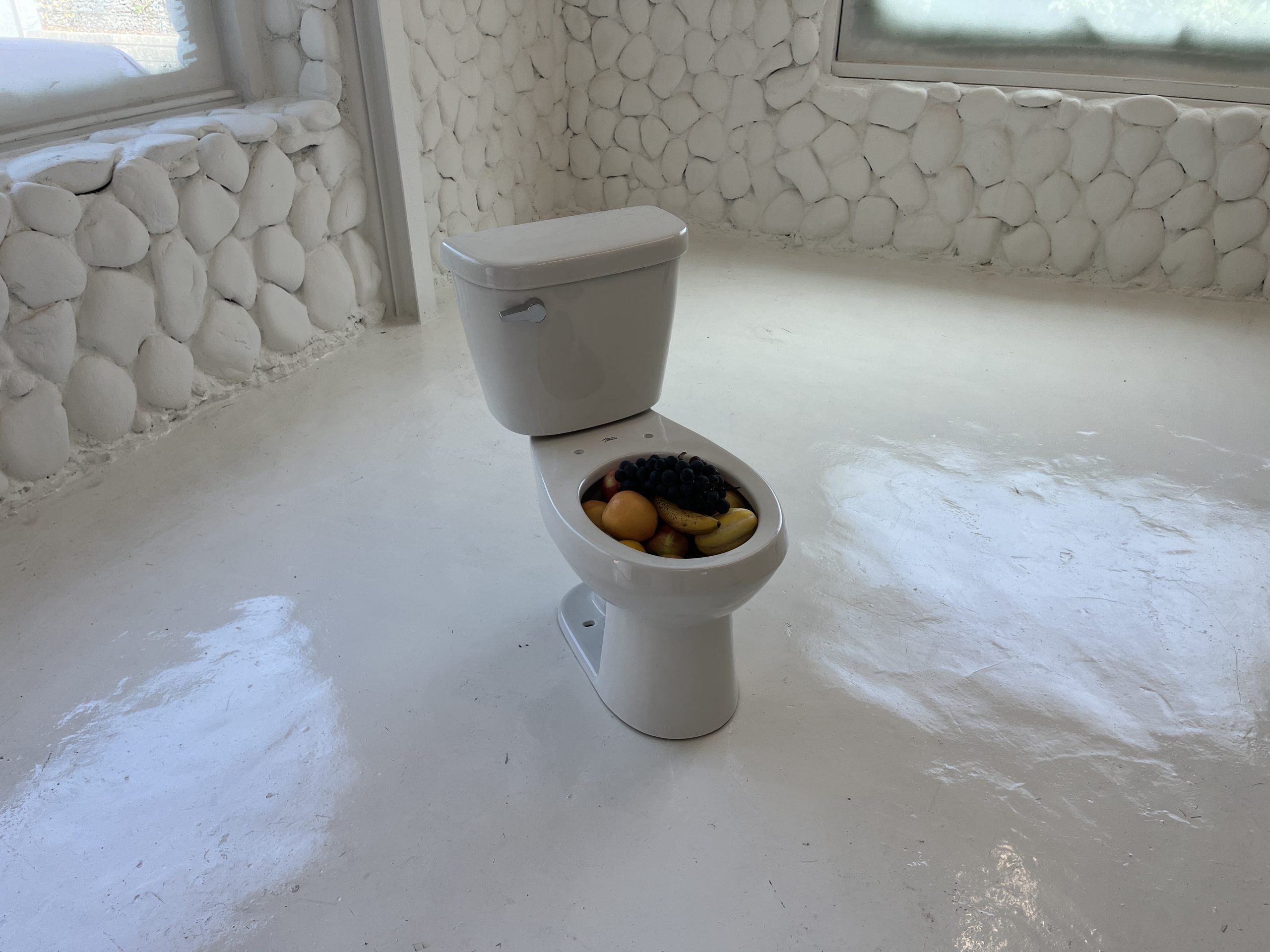
An untitled Urs Fischer sculpture from 2015 at Jason Haam.
If one was seeking international heavyweights in Seoul, they were out in force, too. Sterling Ruby has his art at the Shinsegae Gallery through November 19, beneath the luxe clothing emporium Boon the Shop, where selections from his clothing line are available. Urs Fischer has taken over dealer Jason Haam’s white cube in Seongbuk and a house next door, which he will soon tear down to make way for another. The show is titled “Feelings,” and it runs all the way to December 7. There is fruit in a standalone toilet, new “Problem Paintings,” and an old sedan parked out front painted roughly the same brown color as the road. (Seems dangerous!) Gabriel Orozco is at White Cube through December 14 with paintings and works on paper from his 2021–22 “Diario de Plantas.” They’re sliced-and-diced depictions of plants and animals he’s encountered in Acapulco, Mexico City, and Tokyo, and they’re the most eye-pleasing things he’s done in years, maybe ever. New York legend Nari Ward is at Lehmann Maupin through October 19, also with a birdcage (but bearing shoe tongues, rather than a compact painting). Joan Jonas has a display of her majestic kites hanging from the ceiling of the Gladstone Gallery through October 12. And last but not least, works from the heavyweight-filled Pinault Collection (Felix Gonzalez-Torres, David Hammons, Yi, and more) are on view at the Songeun Art and Cultural Foundation until November 23.
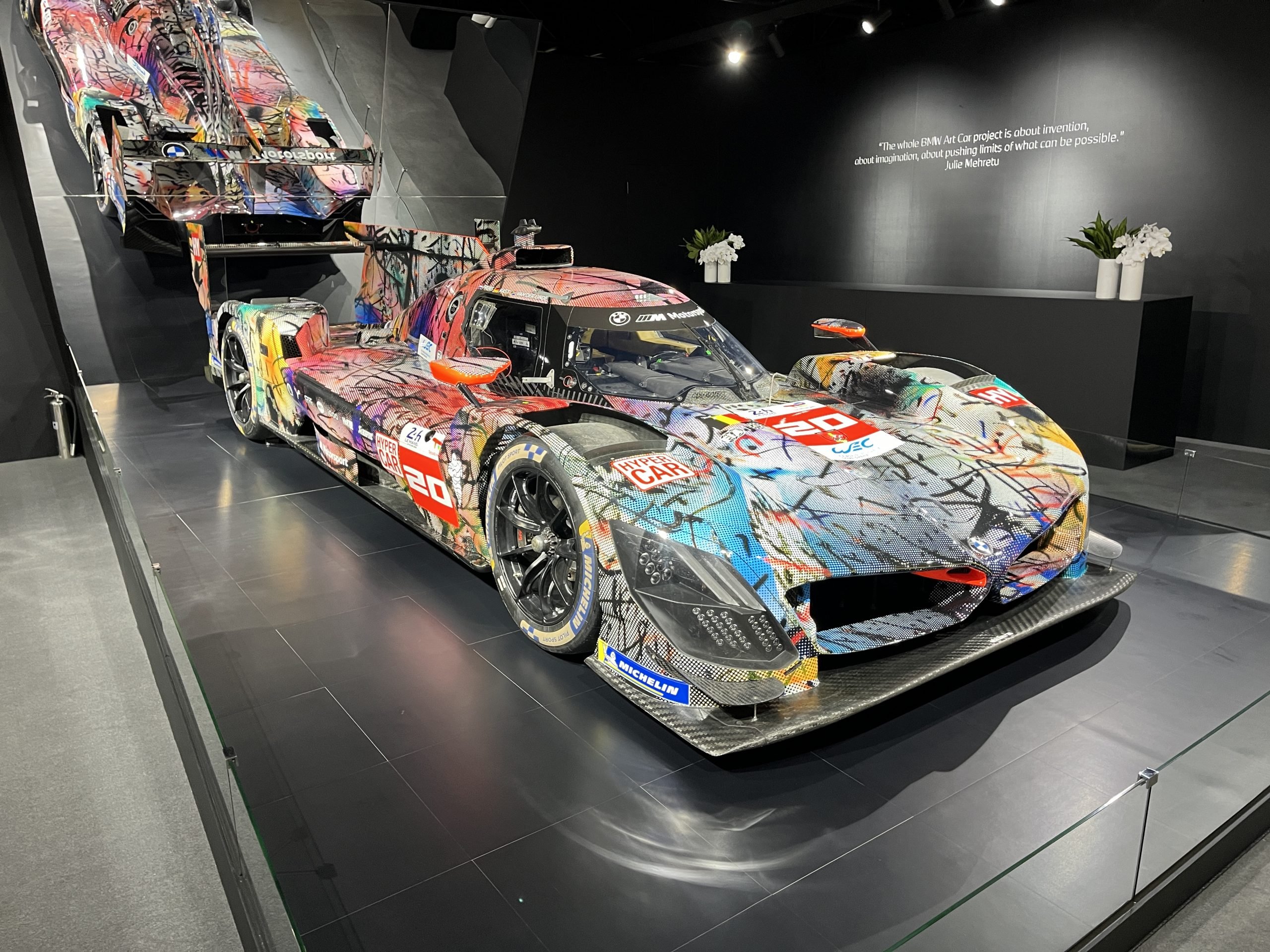
Julie Mehretu’s BMW Art Car at Frieze New York. It looks fast!
Big-name artists and big-league galleries are, of course, two signs that an art week has fully arrived. But it’s the big-budget brand collaborations that can really take matters to the next level. At Frieze, BMW presented a race car with a (very frenetic) paint job conceived by Julie Mehretu, while Illy hawked espresso cups bearing the trademark gradient washes of Lee Ufan.
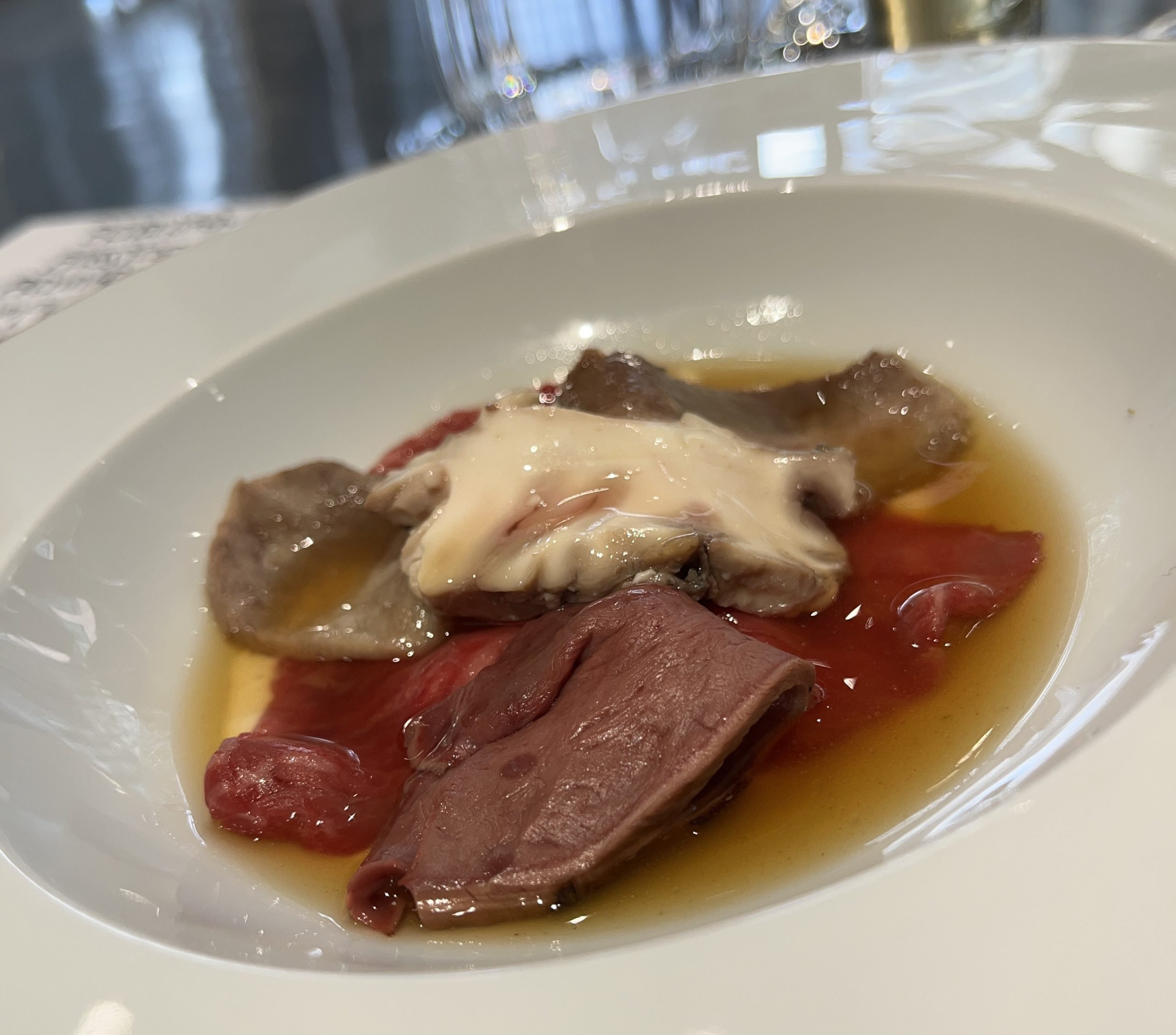
A Brutalisten dish inspired by gomguk (beef bone soup).
Over in Seongsu, the so-called Brooklyn of Seoul, Porsche took the trophy for the most ambitious corporate venture, a multifarious project called “The Art of Dreams” that involved Capsule, the astoundingly lush design tome from the Kaleidoscope gang. There was art, by Ezra Miller, Kwangho Lee, and others; there was a series of talks; there was a Porsche parked in one gallery; and there was a lunch by Brutalisten, the Stockholm restaurant of Carsten Höller whose manifesto calls for dishes to be cooked with only a single ingredient, plus water and salt. (When foreign boîtes begin alighting for art fairs, you know things are getting real.)
Addressing the assembled diners, Brutalisten chef Stefan Eriksson praised the quality of ingredients at the local markets. “Thank you, Korea, for having this wonderful produce!” he said. His cow dish stole the show: a bowl of thin, supple slices in a somewhat-unsettling range of colors, from cream to smoldering red to mushroom gray. Never before have I tasted meat that so clearly declared, “I am the flesh of a dead animal.”
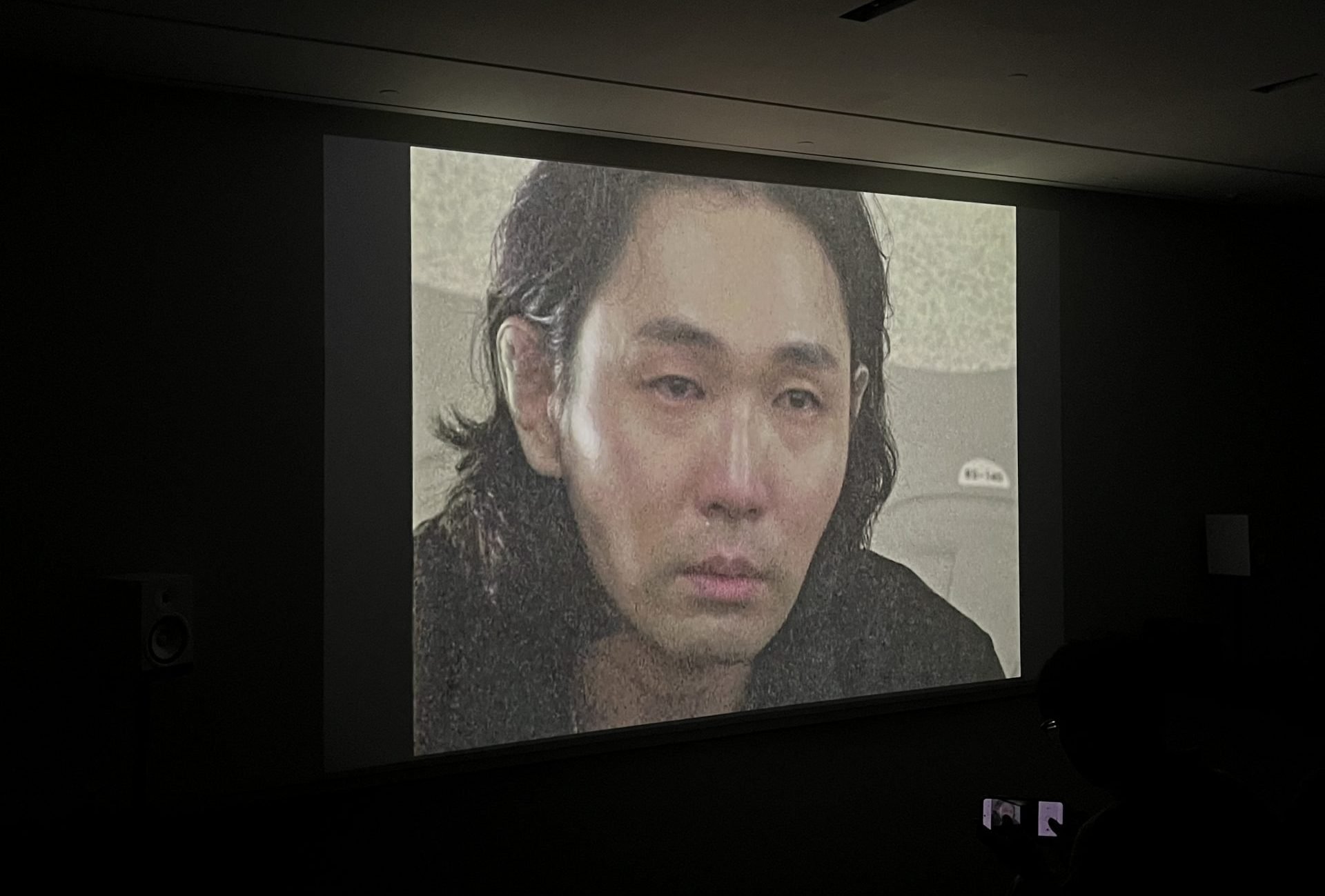
One channel of Heecheon Kim’s two-channel tour de force, Studies (2024), at the Atelier Hermès.
But let’s get back to art.
As it happens, the best thing I saw all week was actually on view thanks to a luxury brand’s largess. That was Studies (2024), a genuinely terrifying horror film by the excellent video artist Heecheon Kim, which I caught on the last day of Frieze, right before leaving town. It’s not the sort of fare one expects from a seller of $600 scarves, but there it was, screening at the Atelier Hermès, in the basement of the firm’s massive store in Dosan Park. If you are in Seoul on or before October 6 and miss it, you are committing a grave crime. The two-channel piece clocks in at about 50 minutes, and (very loosely speaking) follows a wrestling coach as he investigates the disappearance of some of his student-wrestlers.
“Horror movies these days are made in such high-resolution and high-definition,” Kim says in an interview in an accompanying publication, “that they seem to have difficulties with cinematically visualizing uncanny or odd phenomena or creatures.” Without giving too much away: He dodged that issue by incorporating relatively grainy close-up shots of wrestling. In those snippets, a glitch induces a harrowing sense of body horror that remains slippery and only half-legible, even when the coach watches in slow motion. It’s a masterful production, with a lot to say about digital life, and real life, right now, and it ought to tour the globe.
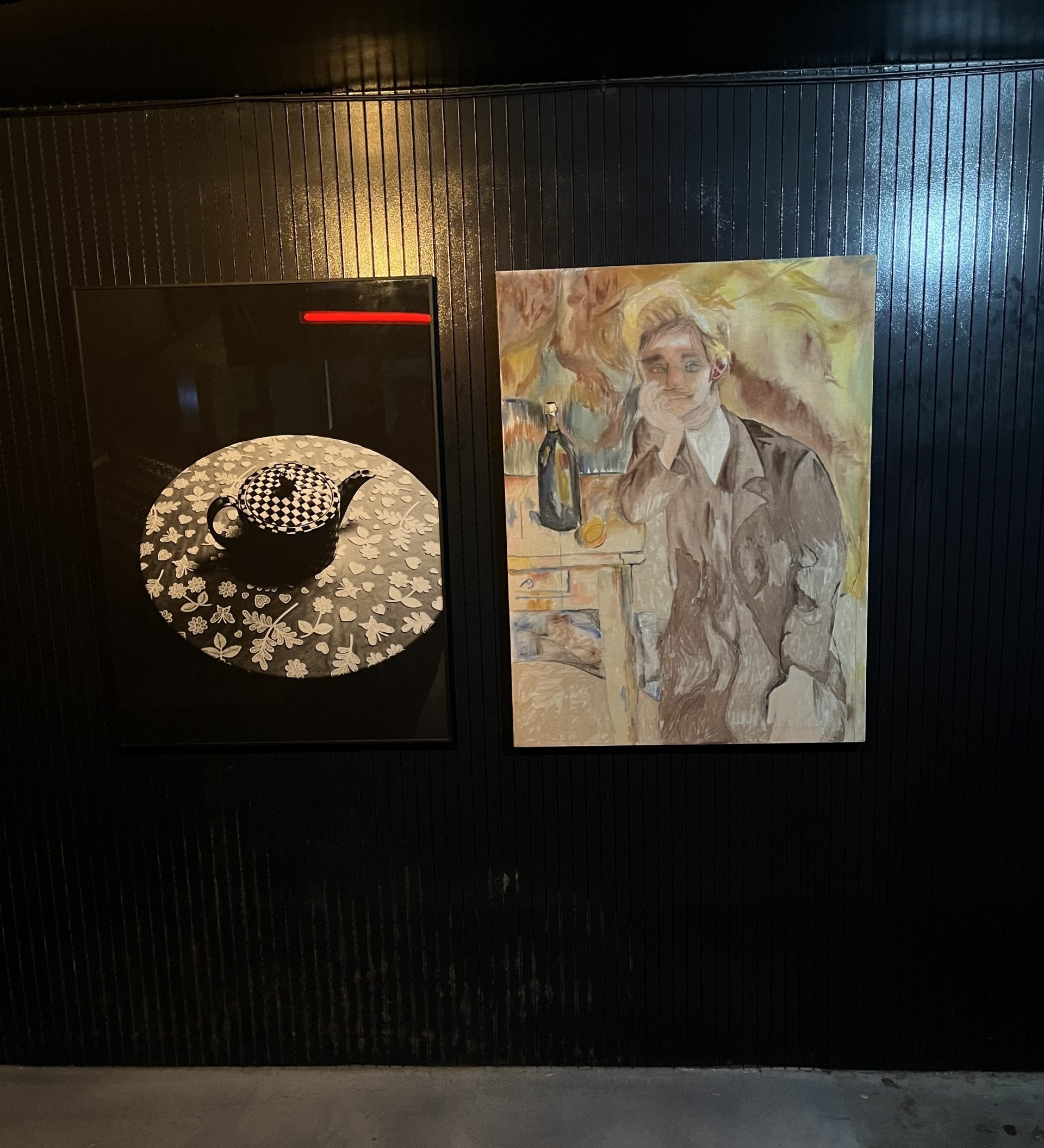
Works by Sohyun Hong and Magnus Peterson Horner on view in Shower’s party at the club Sx.
The hours were ticking down on my flight back to New York, and regret was taking hold. There were so many shows that I still had not yet seen. The pleasure of visiting a city during an art fair is that you get to taste so much—dozens of spaces, thousands of artworks, bracingly rare meat—but there is pain in that, too. You never have the full meal. You are an interloper, on the move, not a regular. As time runs short, you have to triage. What can you skip? What do you have to see?
The galleries were all closed for the night, so I made a final stop at a club called Sx on a hill across the street from Lehmann Maupin. Shower, a recent Seoul upstart, was throwing a party there and had arrayed works around its dark rooms by Mira Mann, Jonghyun Park, and others. It was midnight, the music was loud, and the dance floor was slowly filling up. Things were just getting started.
Below, more photos from Frieze Week in Seoul, with reviews of the Busan and Gwangju biennales to come.
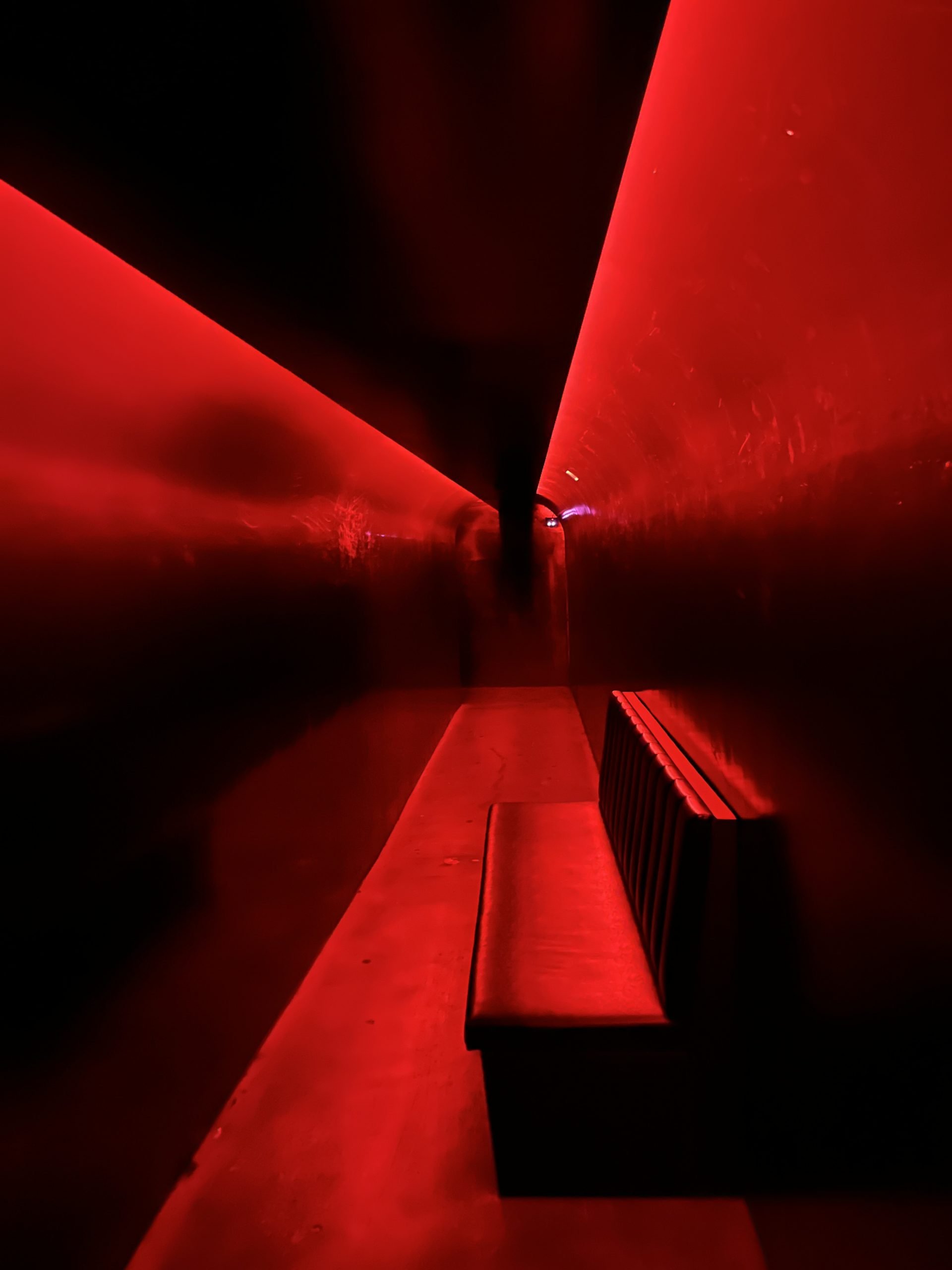
Club Sx.
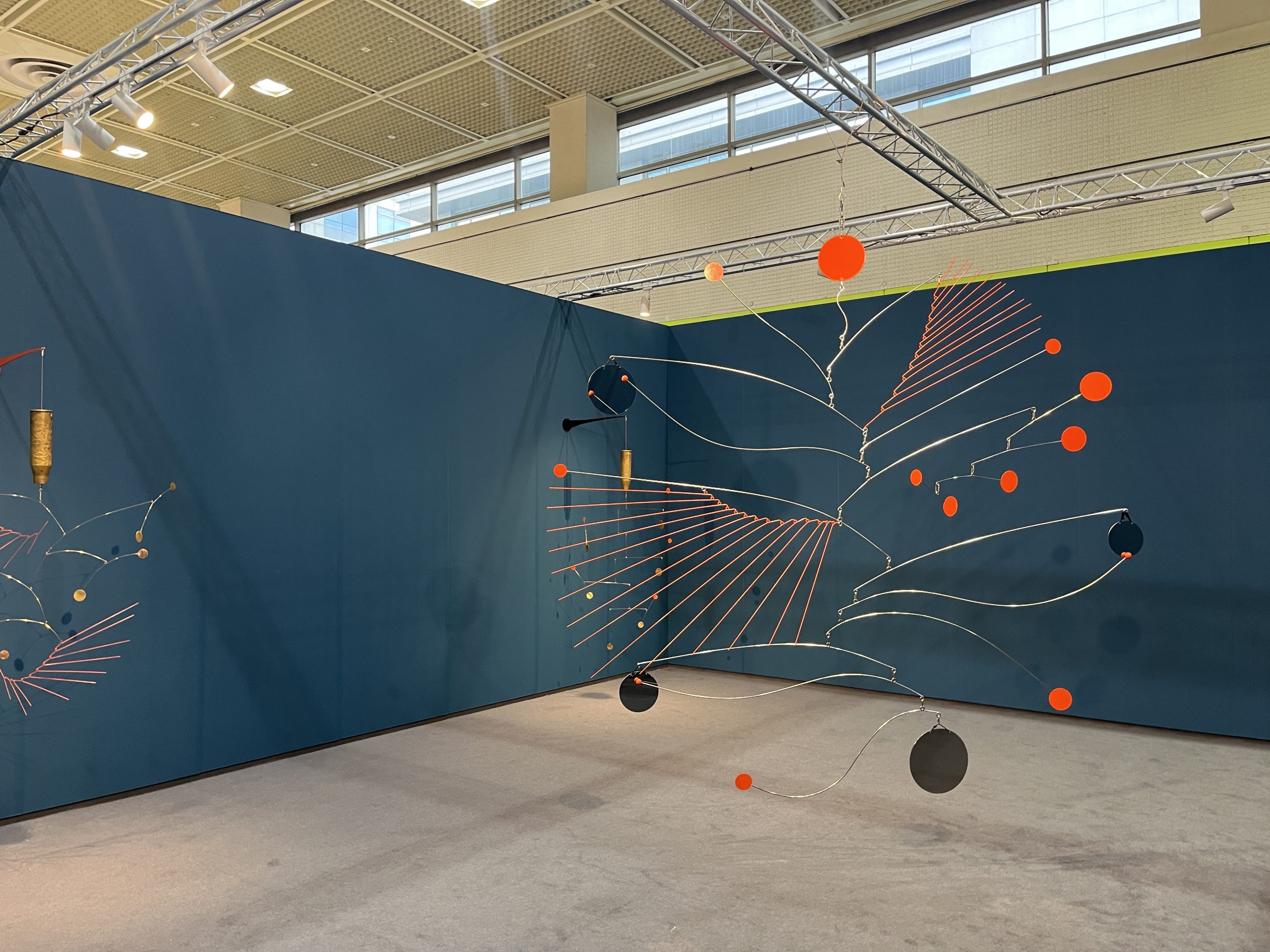
Tuan Andrew Nguyen’s solo Frieze Seoul booth with Galerie Quynh of Ho Chi Minh City, Vietnam. It won the fair’s annual Stand Prize.
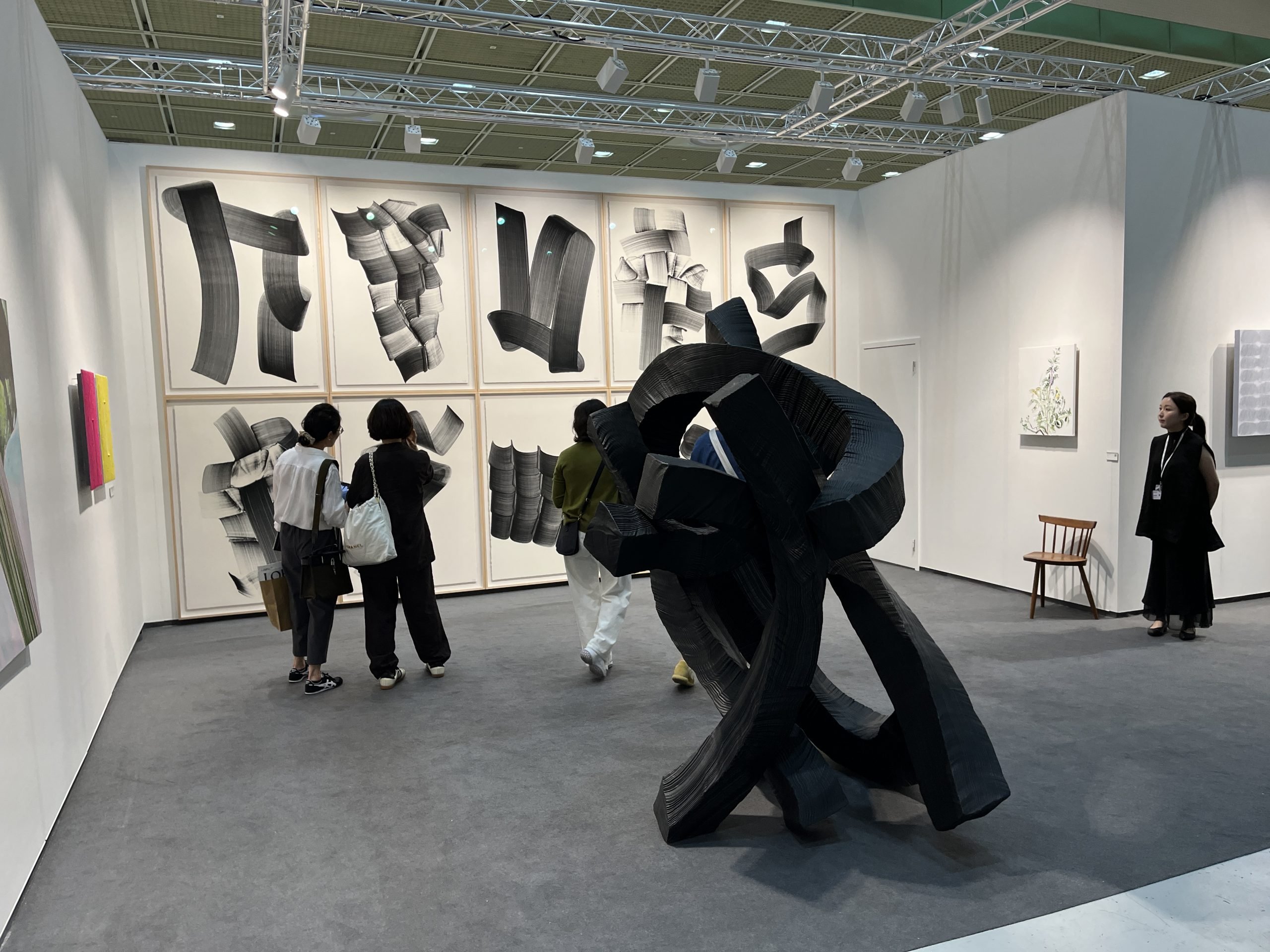
Works by Lee Bae at Johyun Gallery’s Frieze booth.
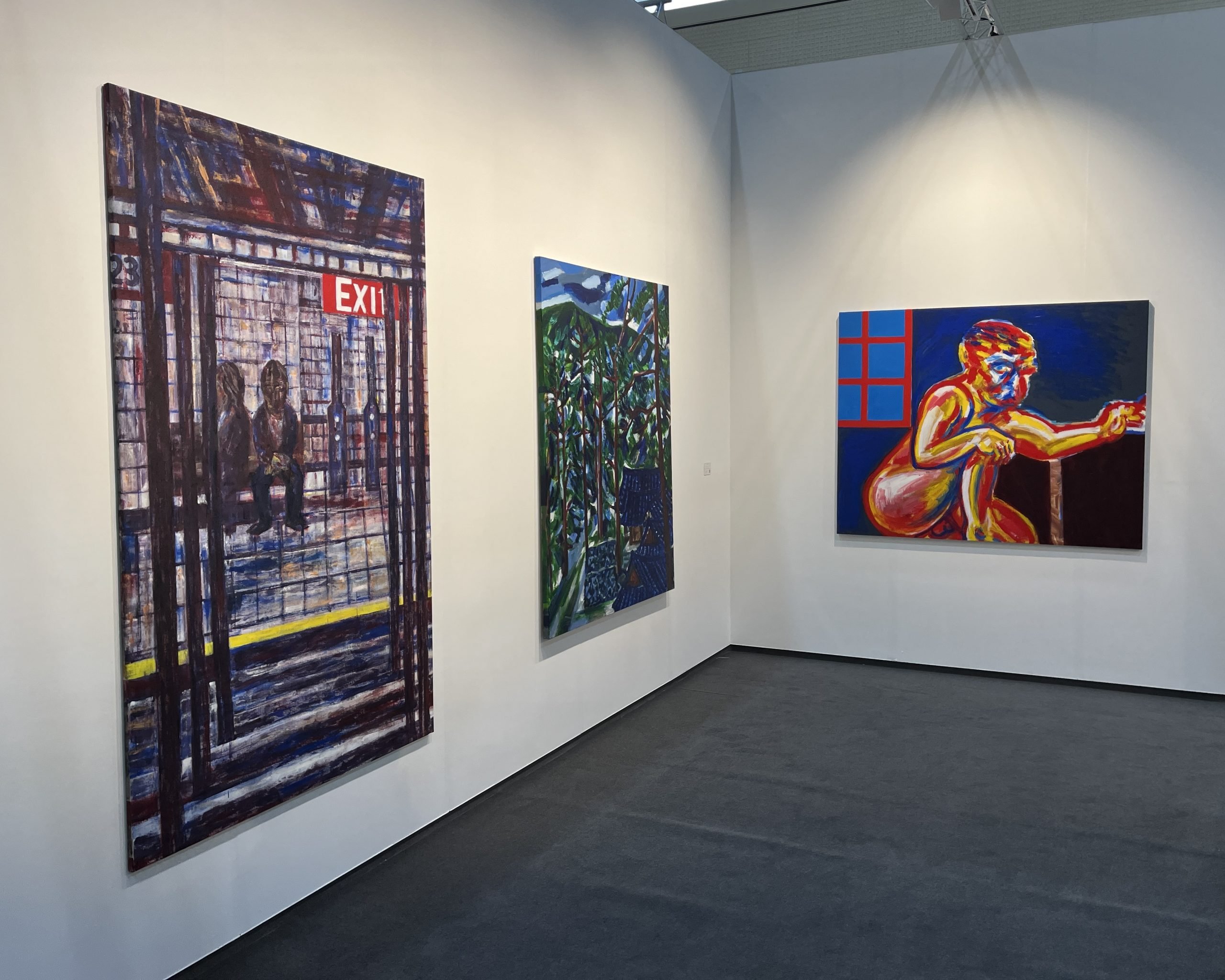
Paintings by Suh Yongsun at One and J Gallery.
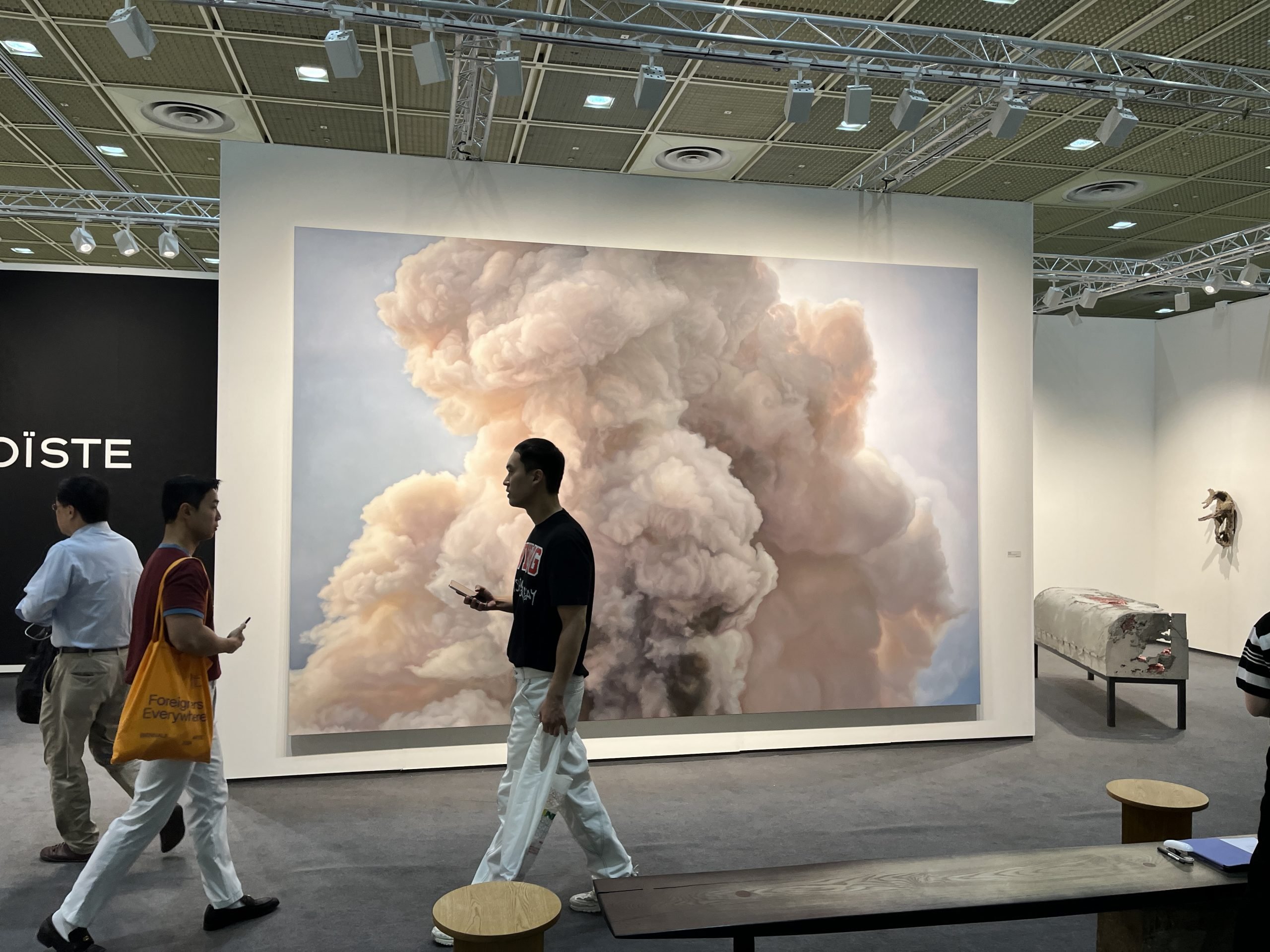
An Anne Imhof painting at Sprüth Magers’s booth at Frieze Seoul.
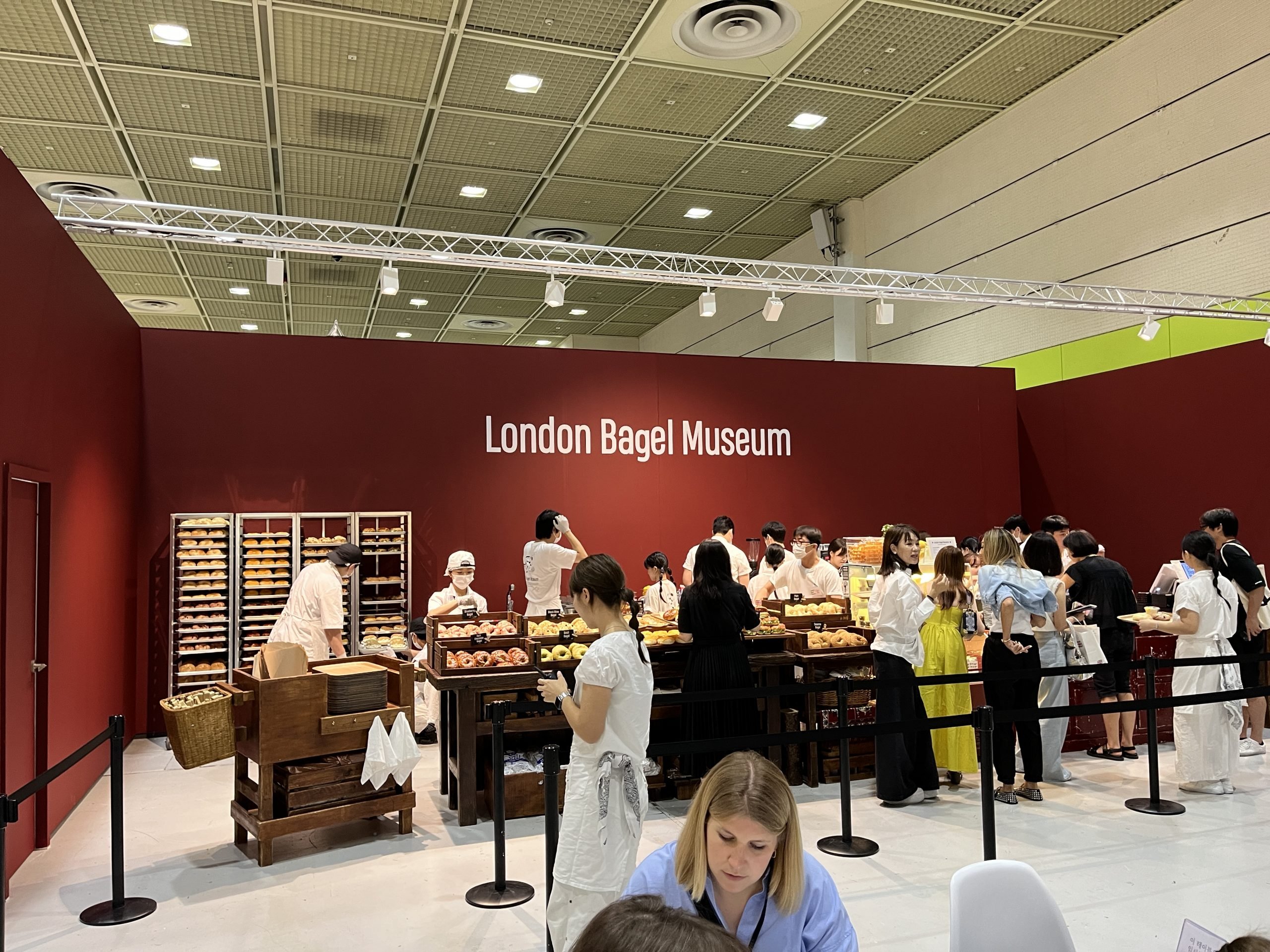
The London Bagel Museum, a Seoul institution, staged a pop-up at Frieze.
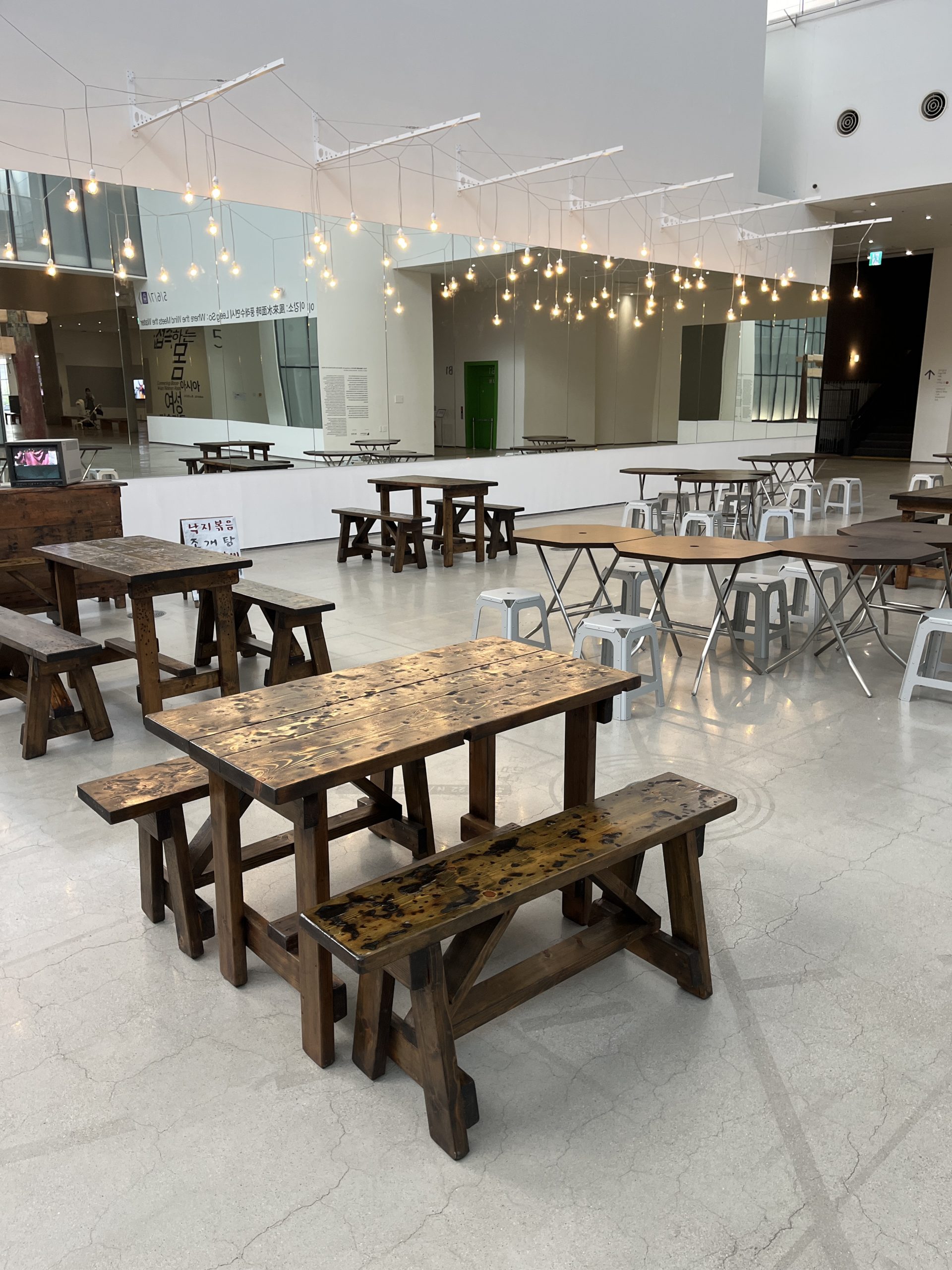
A glorious surprise at the MMCA: Lee Kang-So’s seminal Disappearance installation was on view in its atrium. Lee first staged it for a week at a Seoul gallery in 1973, serving makgeolli (a Korean rice wine) to visitors. The convivial gathering—relational aesthetics avant la lettre—had a definite political edge under the authoritarian regime of the time. At the MMCA, it’s being presented in collaboration with a group called OURLABOR, which has incorporated mirrors and lights (that seem totally unnecessary). Lee went on to become a remarkable abstract painter, and he just joined Thaddaeus Ropac.
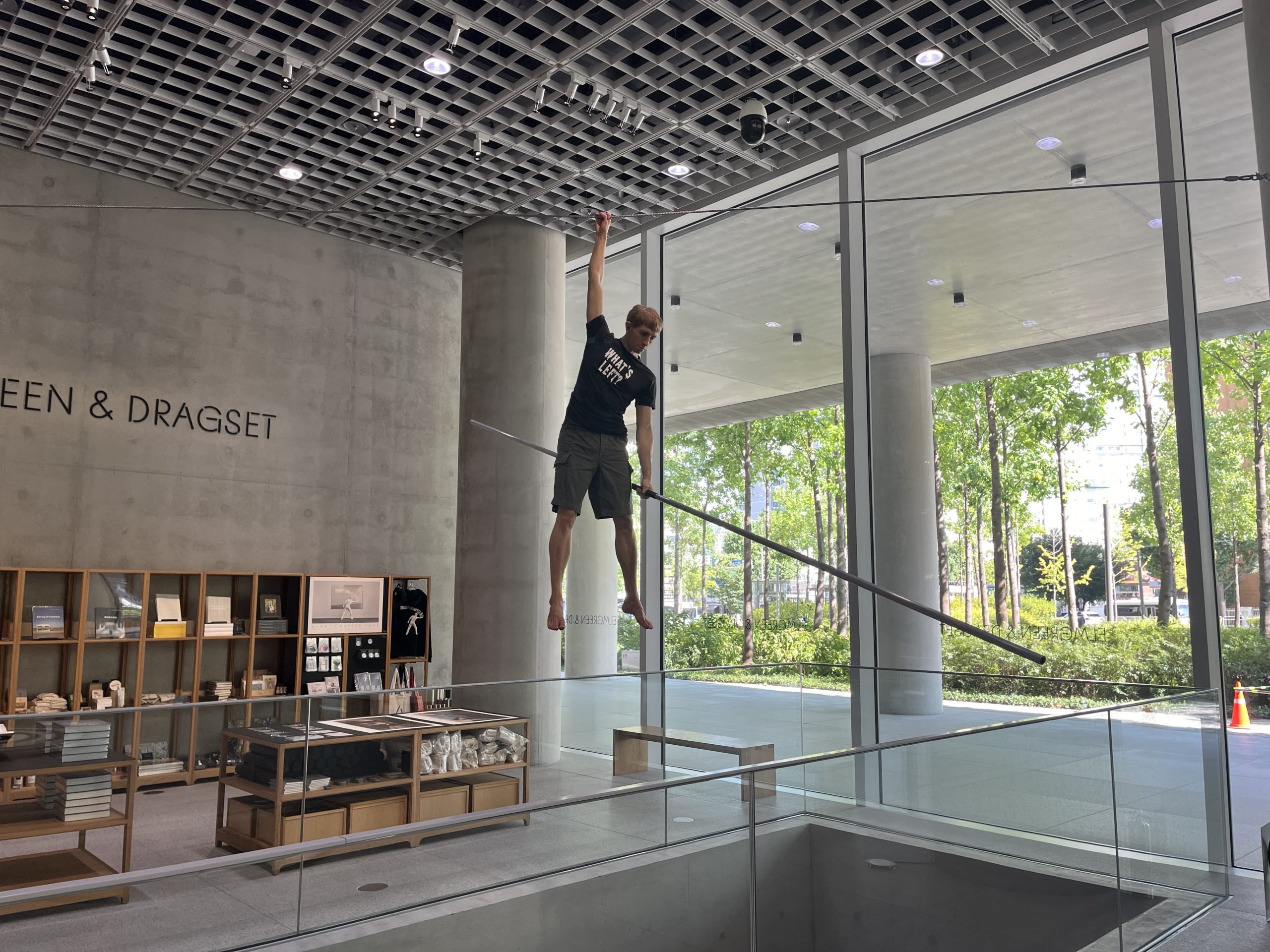
Installation view of Elmgreen and Dragset’s “Spaces” exhibition at the Amorepacific Museum of Art.
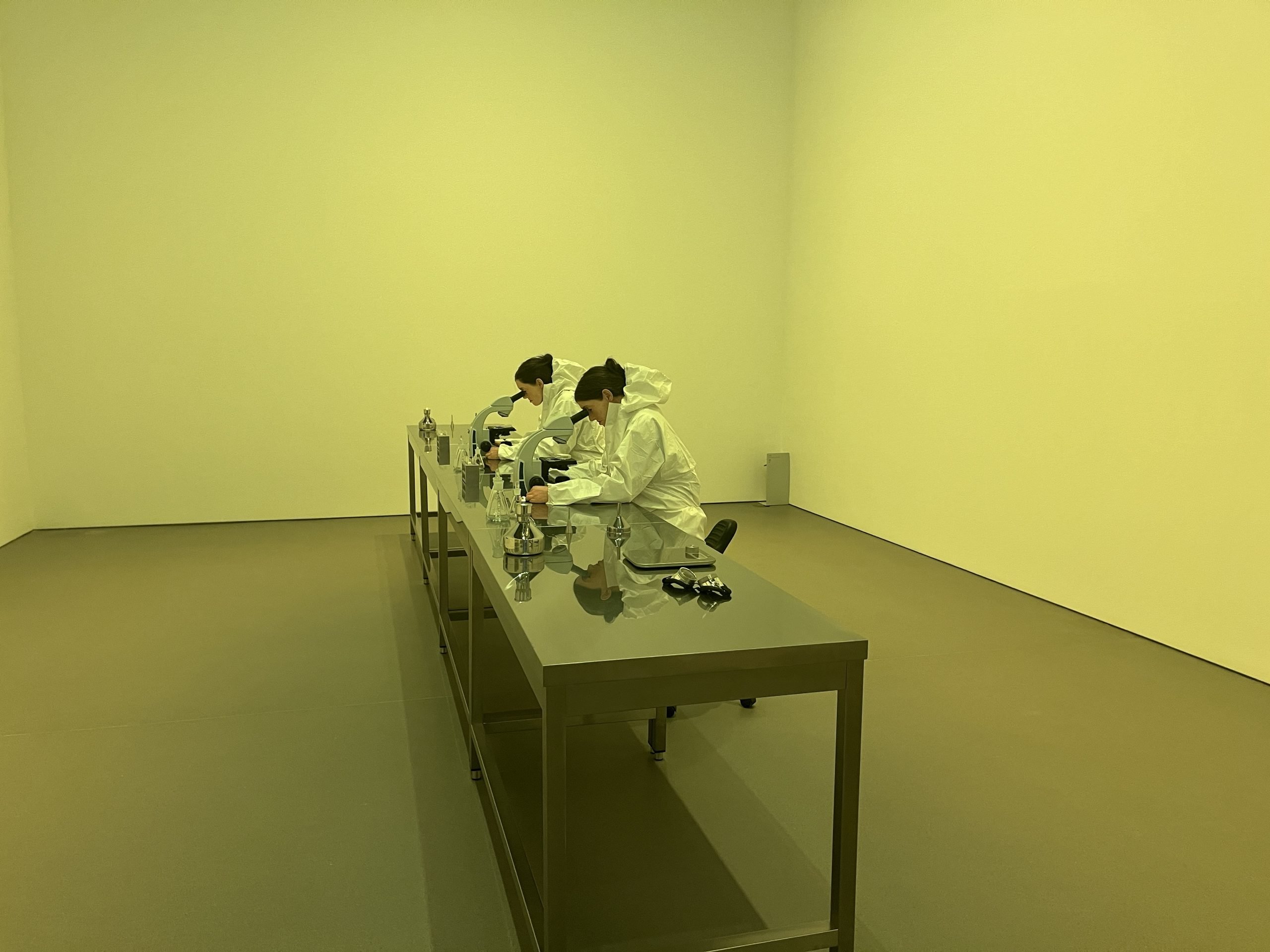
A tense moment in the Elmgreen & Dragset show. I moved through quickly.
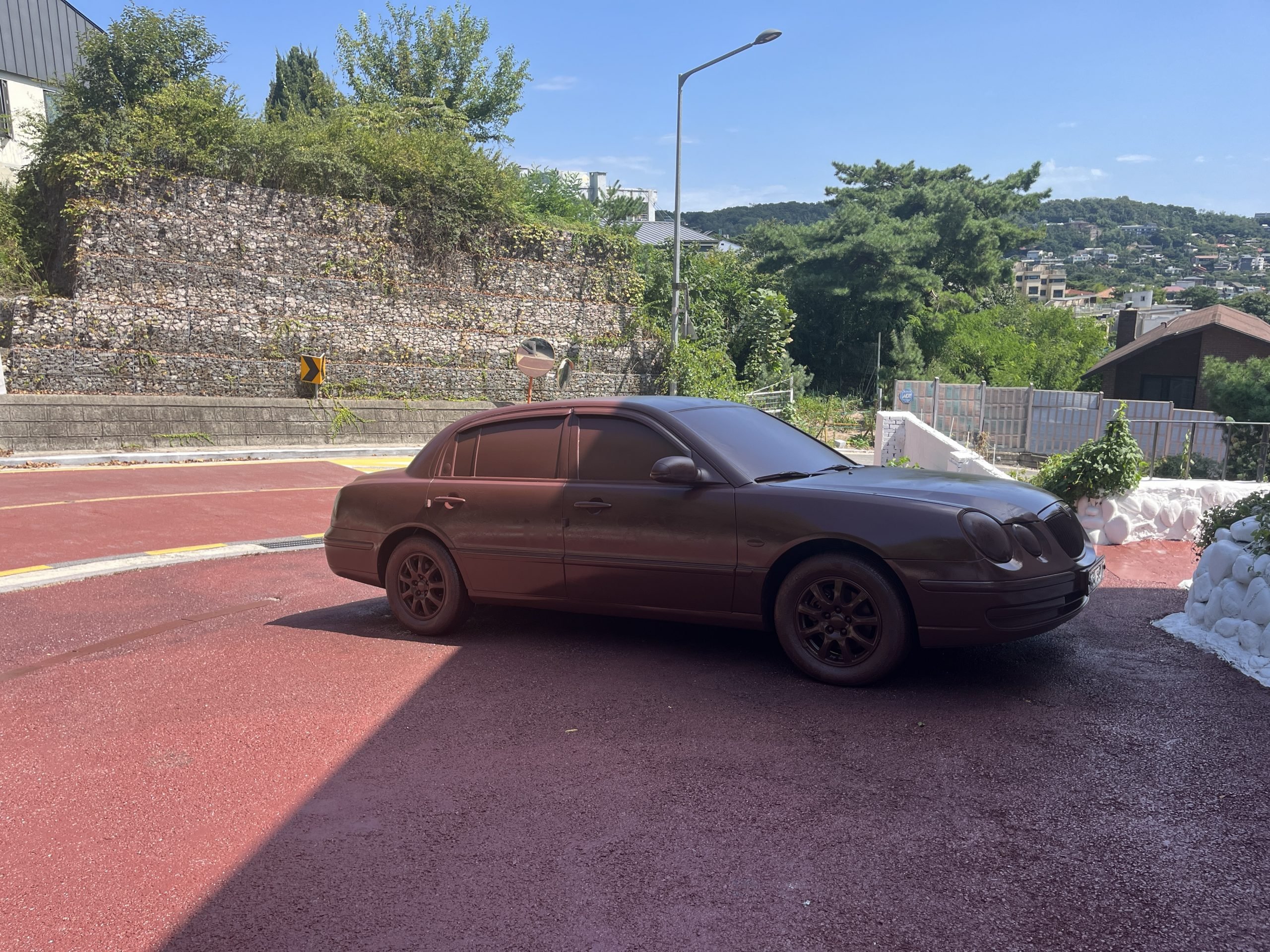
A camouflaged car by Urs Fischer at the Jason Haam gallery.
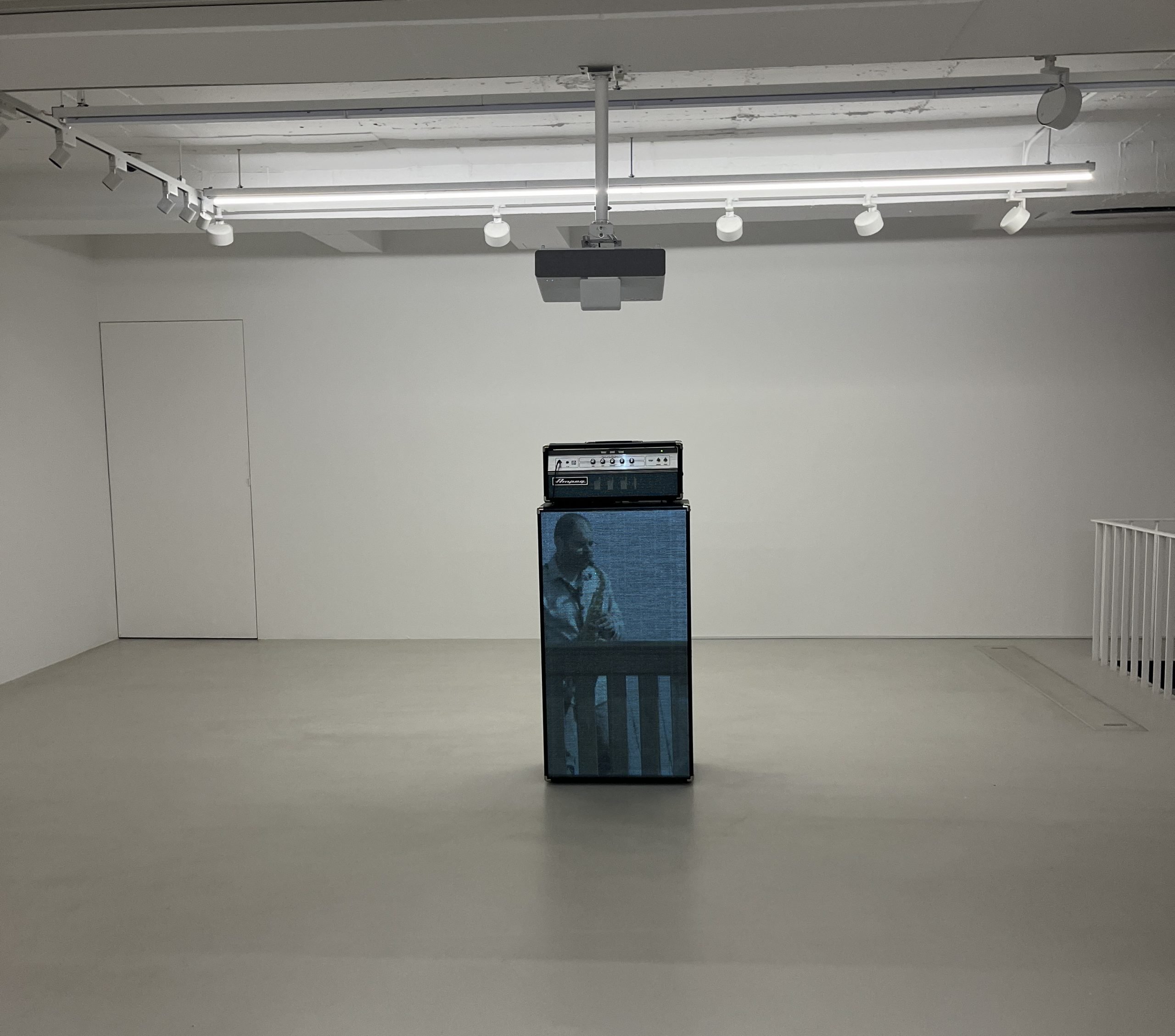
Installation view of the exhibition “Lawrence Abu Hamdan: Zifzafa” at Barakat Contemporary.
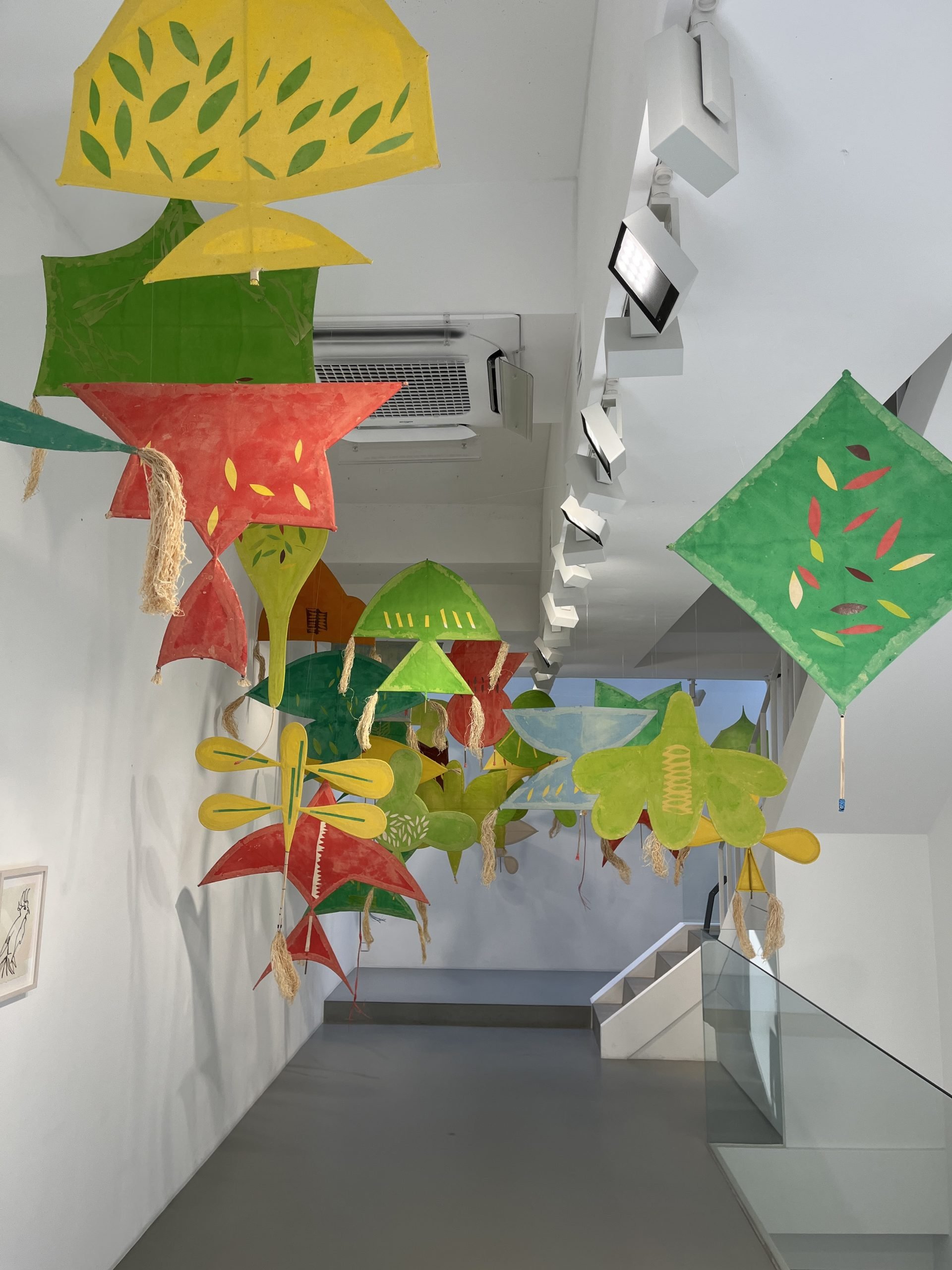
Installation view of “Joan Jonas: the Wind sings” at Gladstone Gallery.
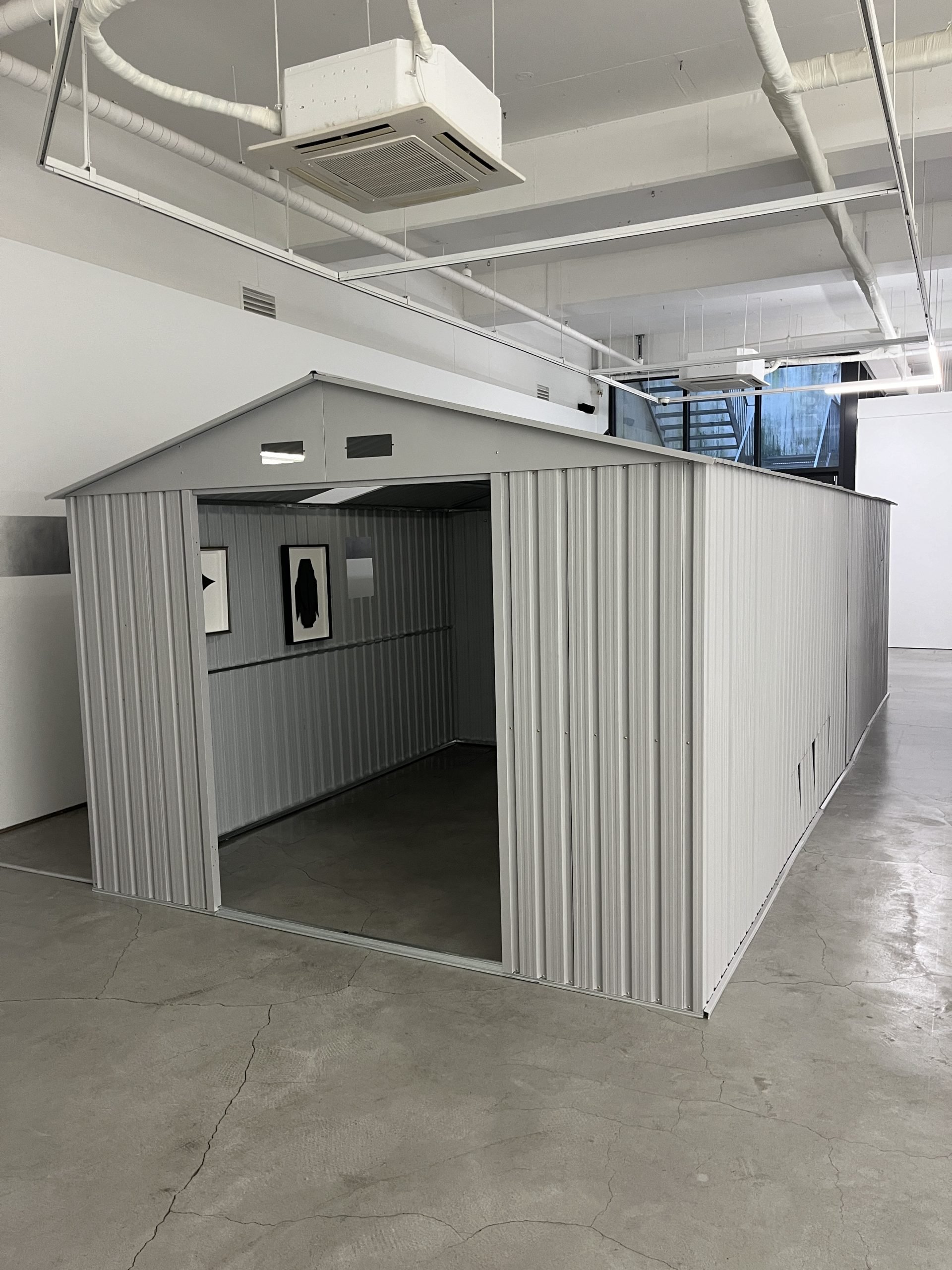
Installation view of “Hwang Sueyon: Pastel, Bullet, Beautiful Fingers” at G Gallery.
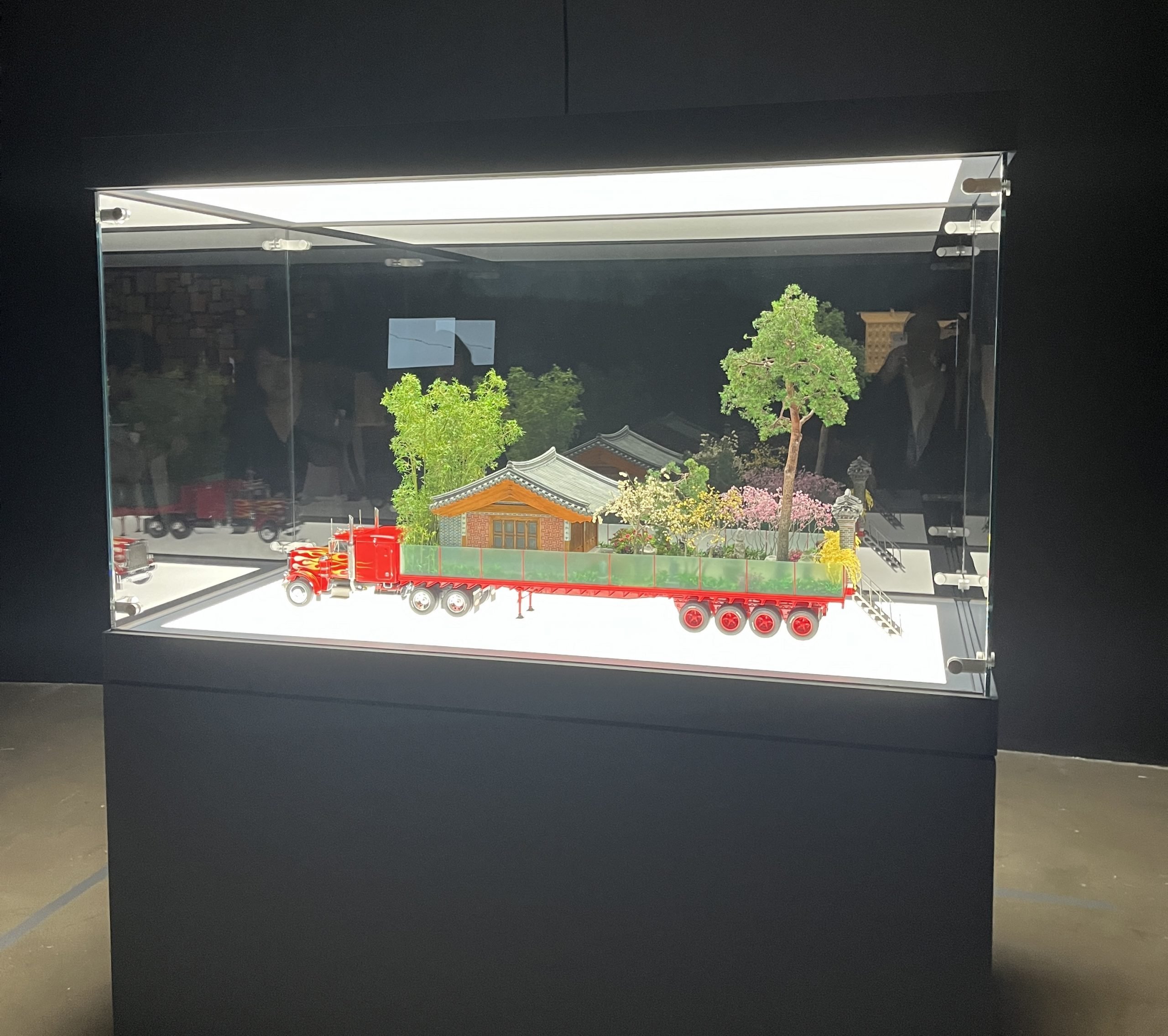
Another work by Do Ho Suh, on view at the Art Sonje Center.
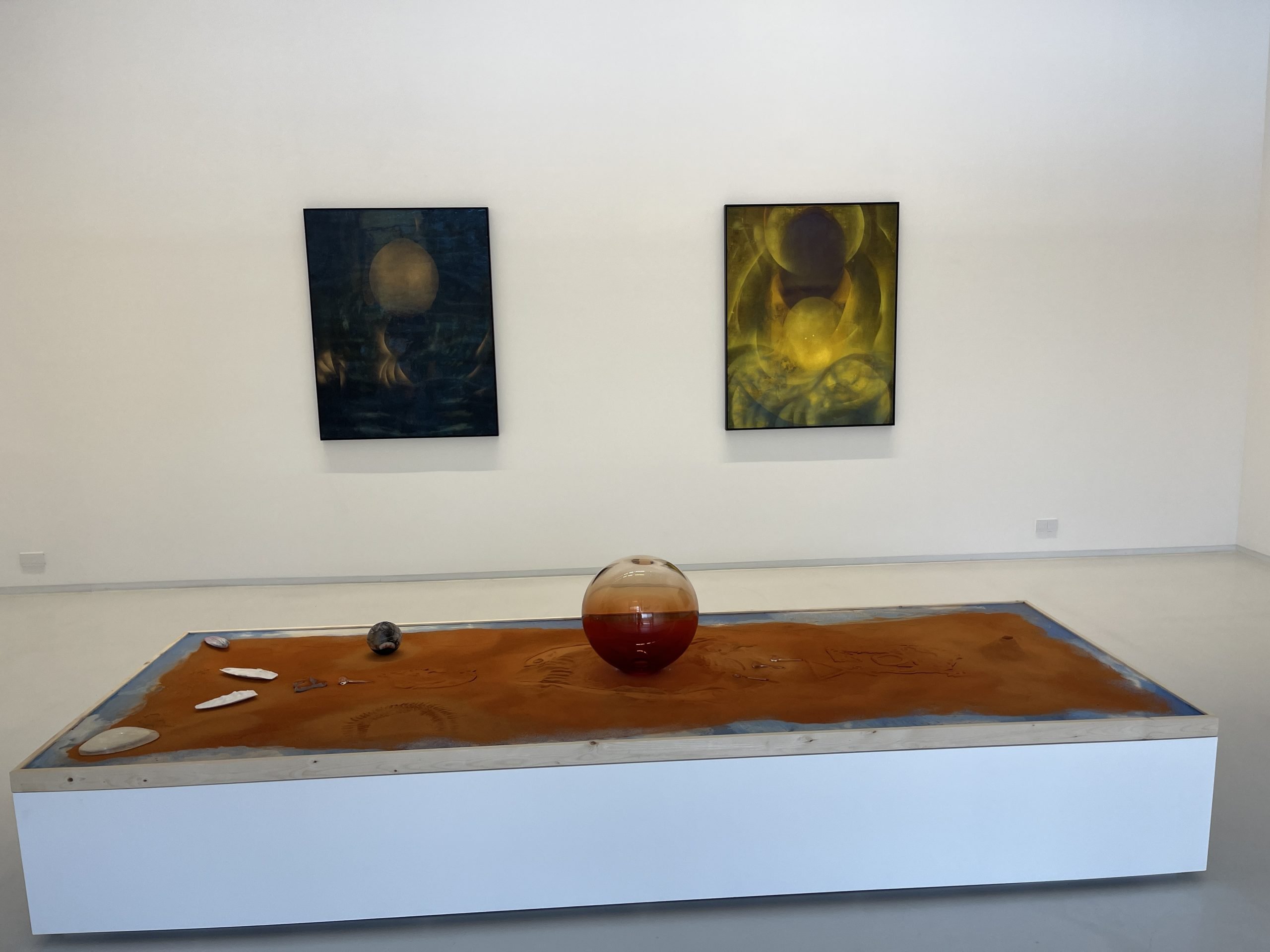
Minouk Lim’s radiant, spectral solo show at BB and M, “Memento Moiré.”
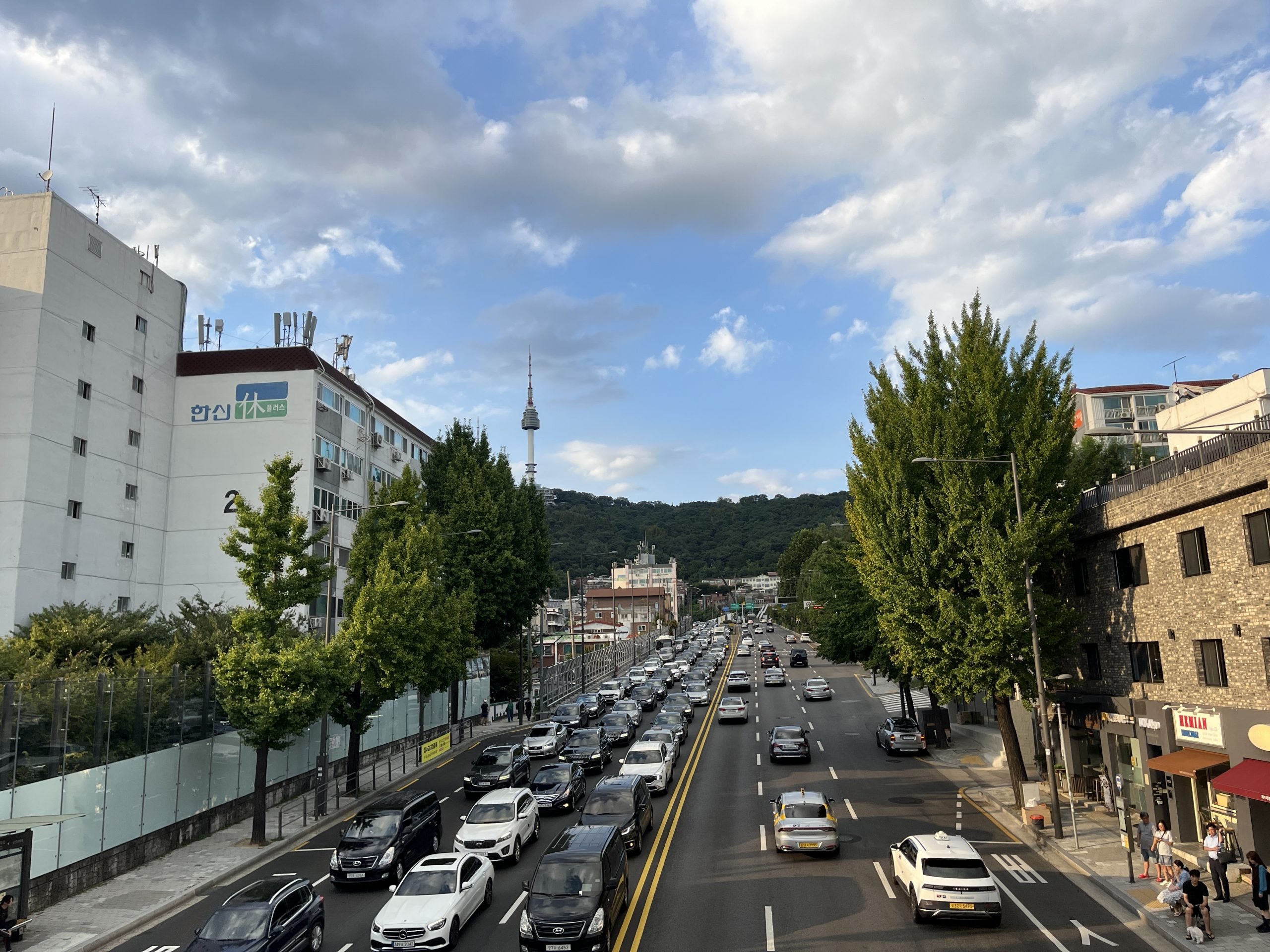
Farewell.
And finally: more food photos.
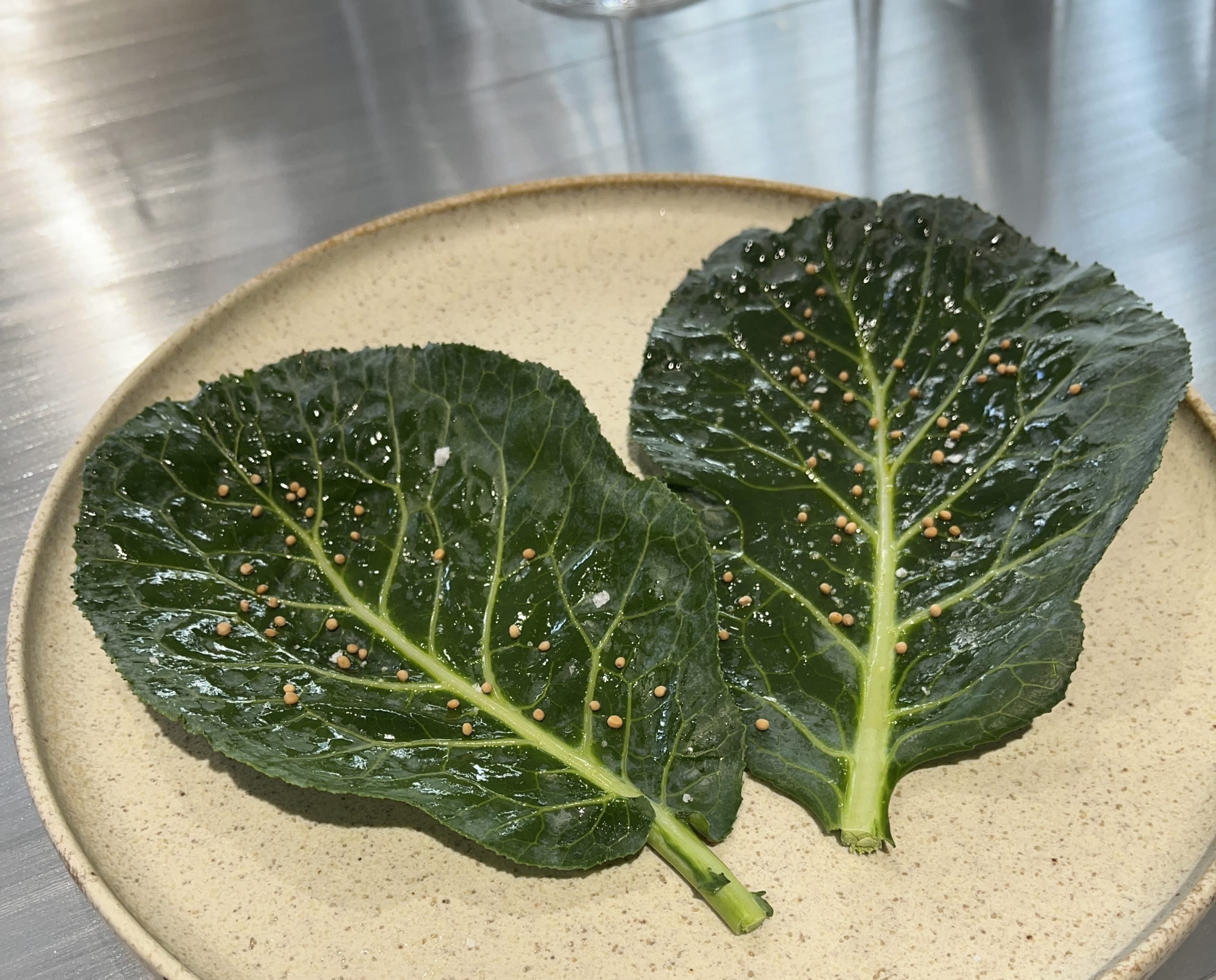
Two leaves, from Brutalisten at Porsche’s luncheon.
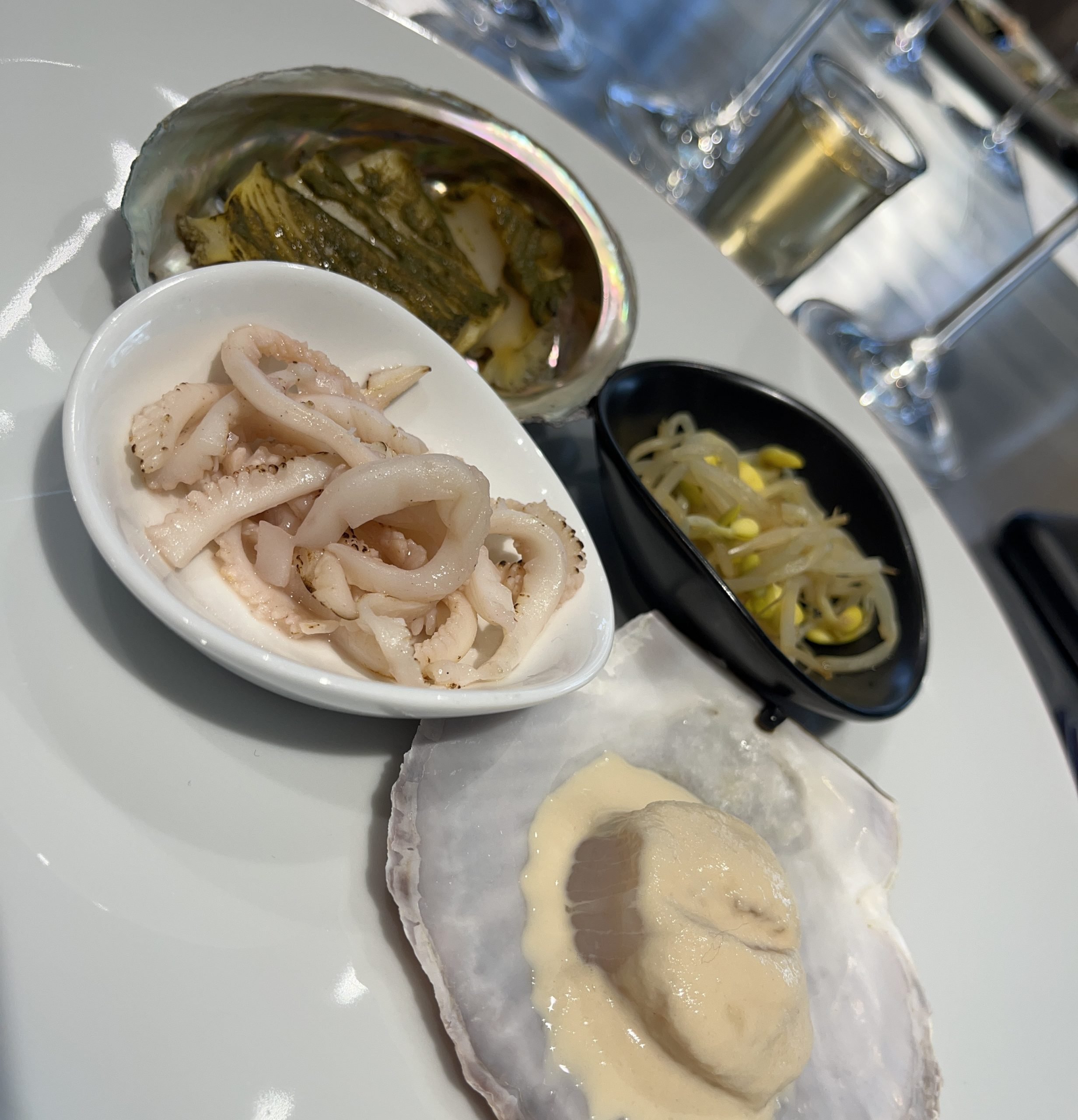
A medley of seafood at the Brutalisten pop-up.
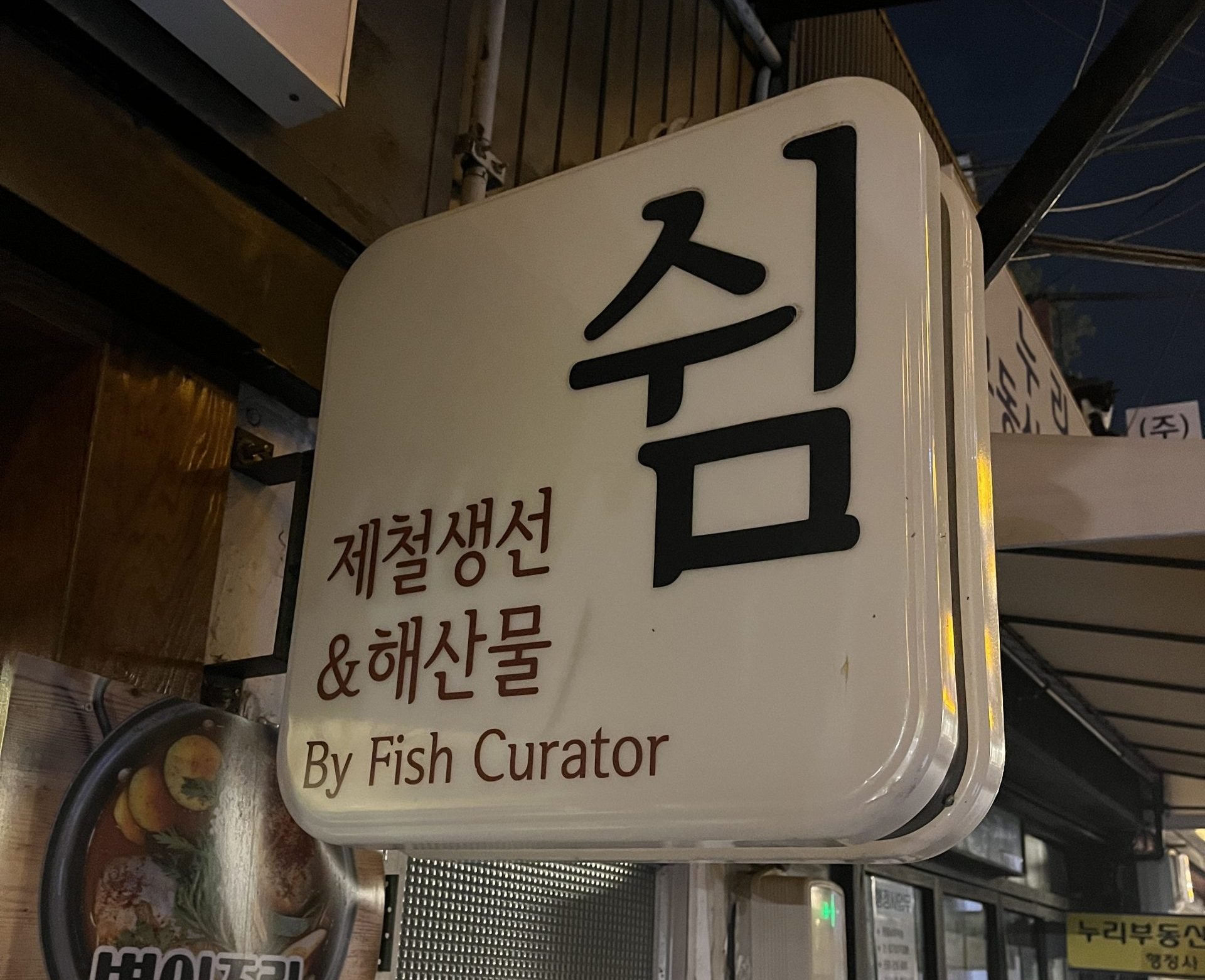
If you are wandering along Sejong Village Food Street in the Seochon neighborhood, stop in your tracks and go eat. Hearty and flavorful seafood awaits you.
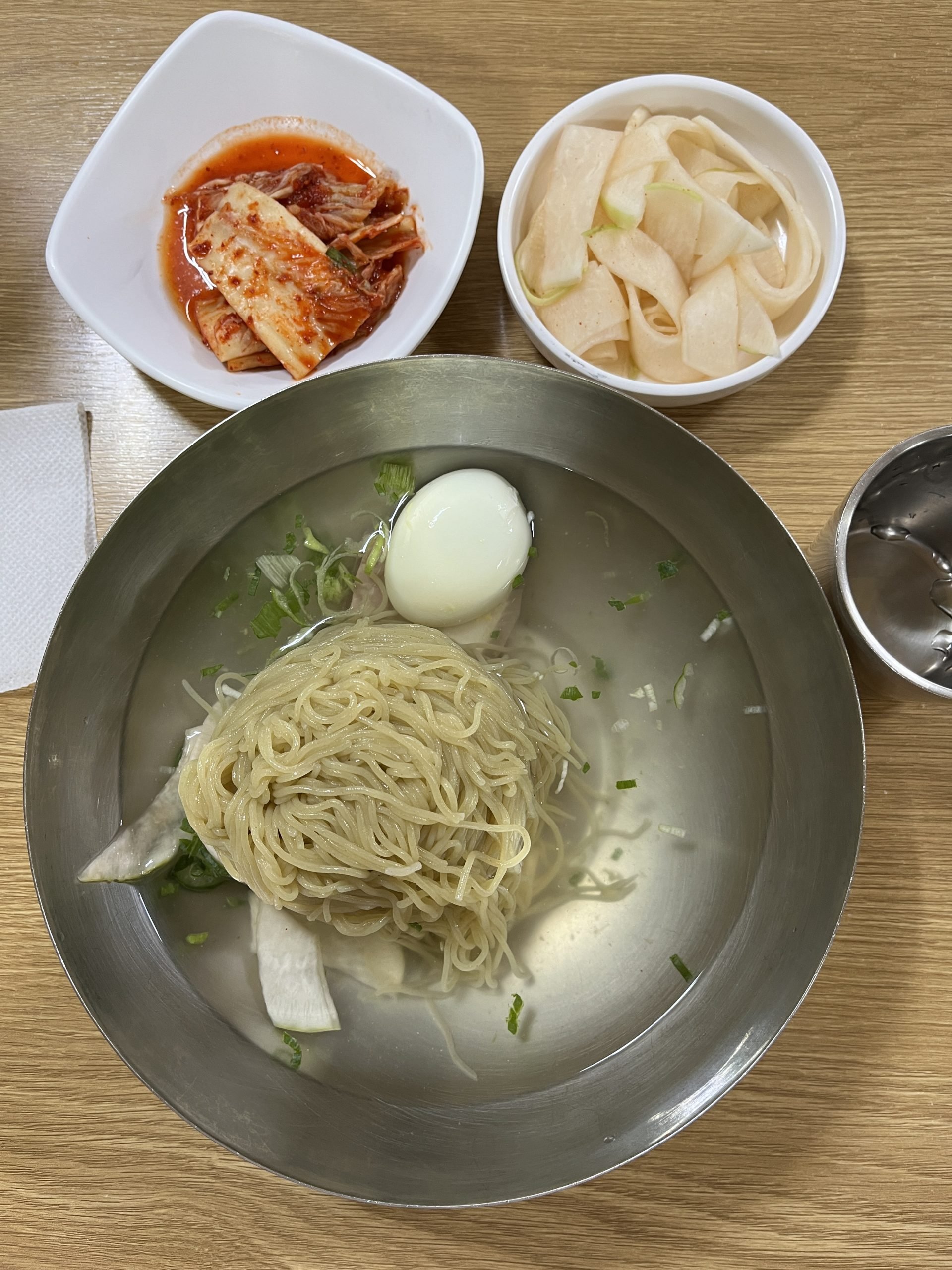
Delicate, subtle, refreshing Pyeongyang naengmyeon at Jinmi Pyeongyang Naengmyeon in the Gangnam district, a short taxi ride or a pleasant walk from the Coex convention center.
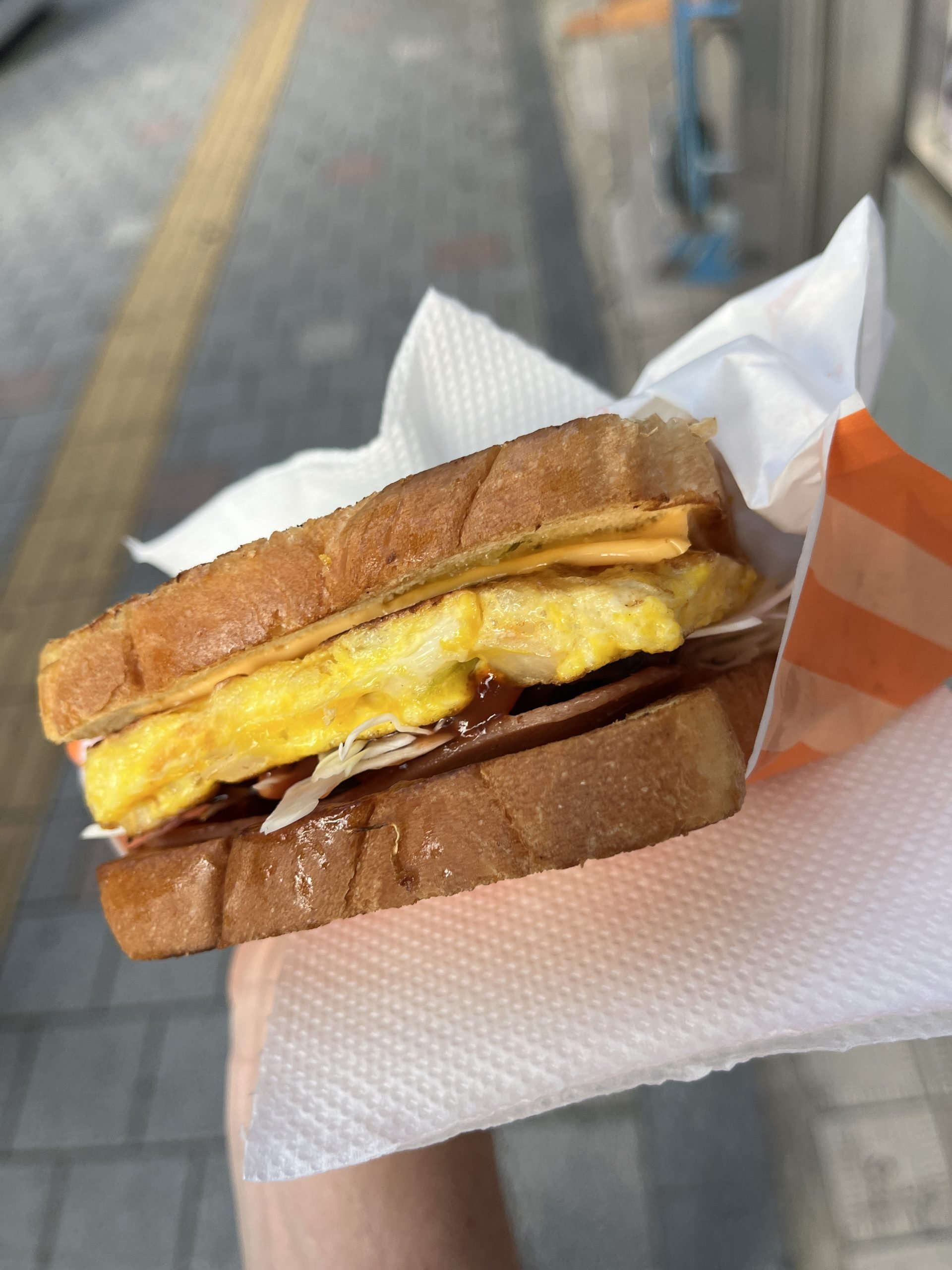
Street toast from Namdaemun market: rich, spicy, and deeply satisfying, an instant cure for jet lag.
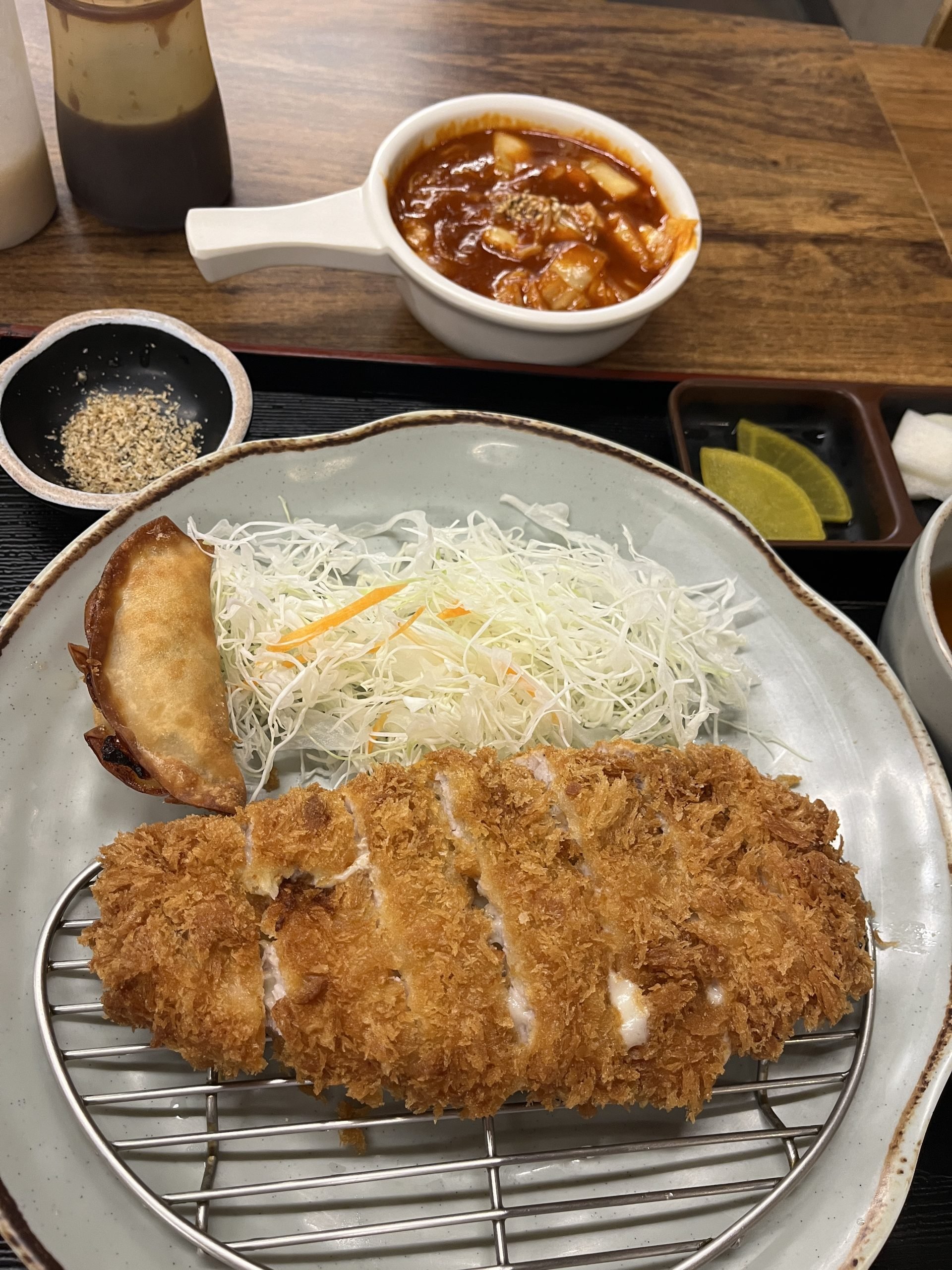
There are countless places to get tonkatsu in Seoul, but my favorite spot is Mesiya, across the street from Seoul Station. Go with the cheese-stuffed version, order the stewed kimchi, and pour it on top, or use it as a dipping sauce. You’ll have wait at noon, but the compact place clears out by 1 p.m. It’s the perfect venue to debrief a series of gallery visits. Afterward the meal, you will need a nap.
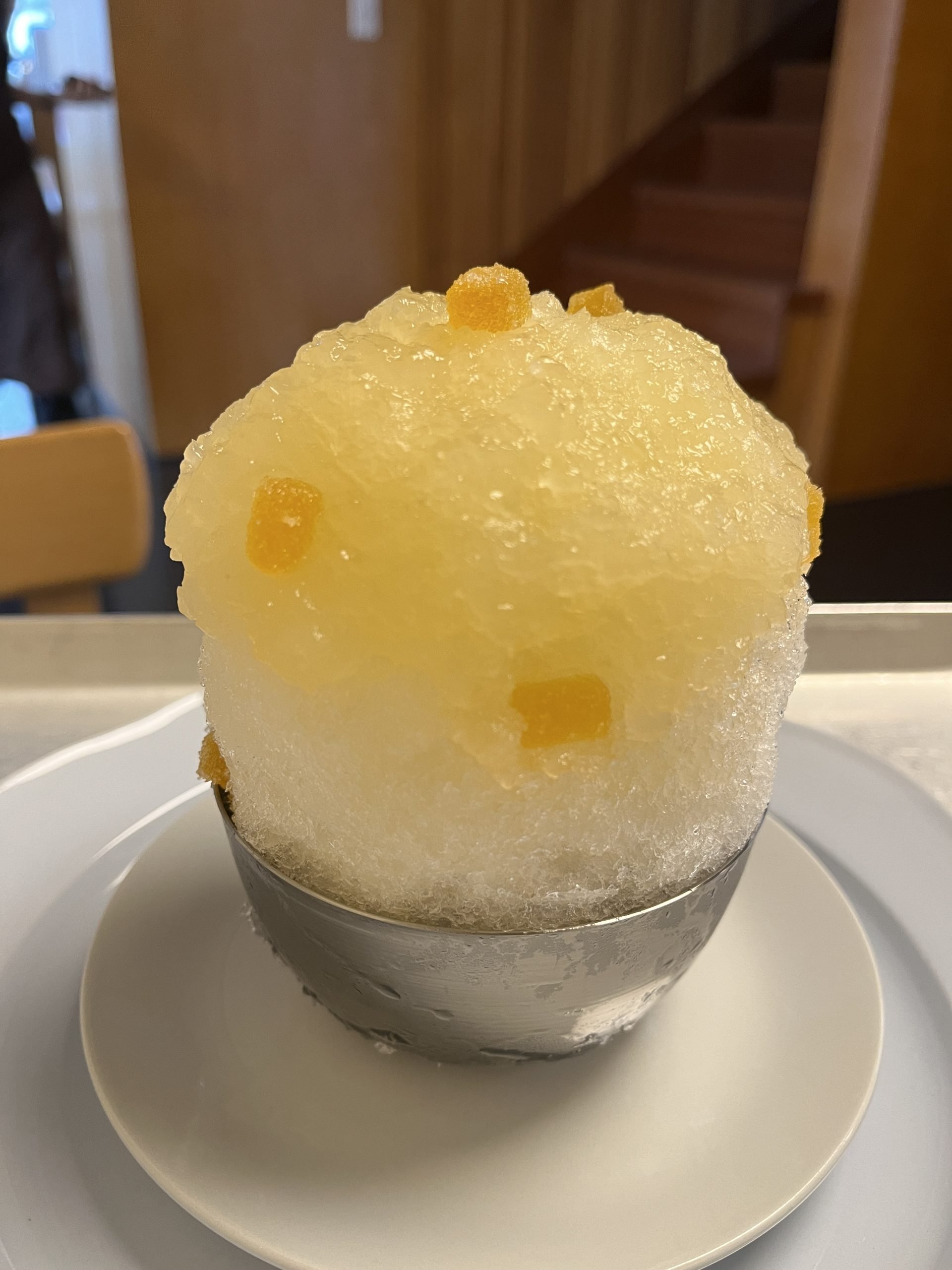
A bingsu to end all bingsus at Maa: chamoe melon coulis, galanga soft serve, and passion fruit pâte de fruit. Like a well-organized art week, it can change your life.